Andrew Dufresne, UST, US
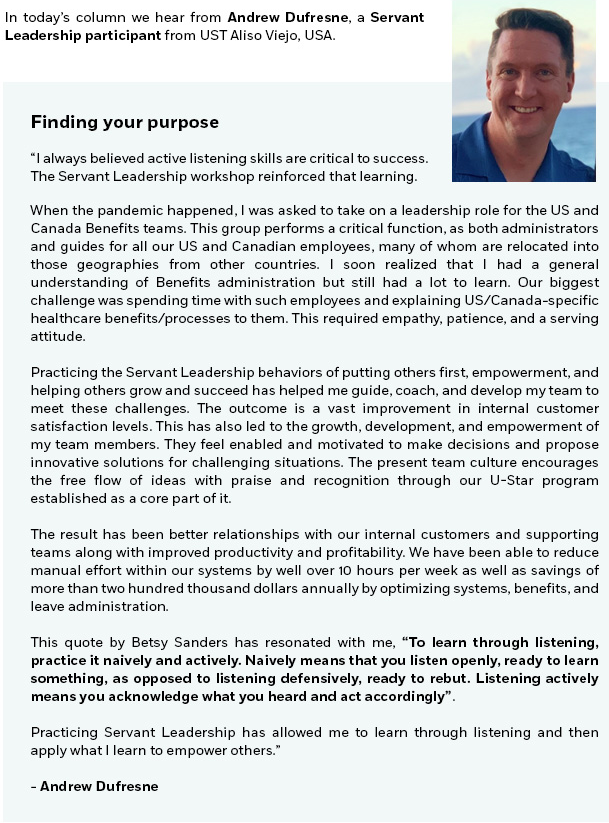

Andrew Dufresne, UST, US


Gordon Alexander, UST, UK
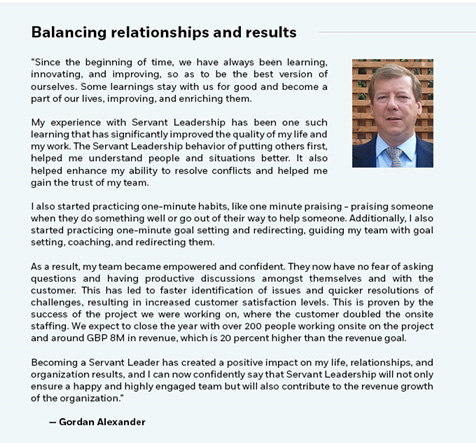
Servant Leadership is not a new term or a new leadership philosophy. It has been around for many years now, but it is being “re-discovered”, as organizations are driven by agile teams that need to be empowered with the power to make their own decisions.
UST has embraced Servant Leadership as the overarching Leadership philosophy as this leadership philosophy helps us keep the employees at the center of everything we do, and balances beautifully between Results and Relationships.
Servant-leadership encourages leaders to enable their team to become successful, by becoming coaches and guides who harnessing the collective power of a team to achieve a set of agreed outcomes. It helps create and offer a participatory environment, to help build a more cohesive culture, improve employee experience, and nurture innovation in the organization from the grass roots upwards.
Let’s listen to Dr Madana Kumar, our Global Head for Leadership Development and a well known Servant Leadership evangelist, talk about Servant Leadership and it’s relevance for UST:
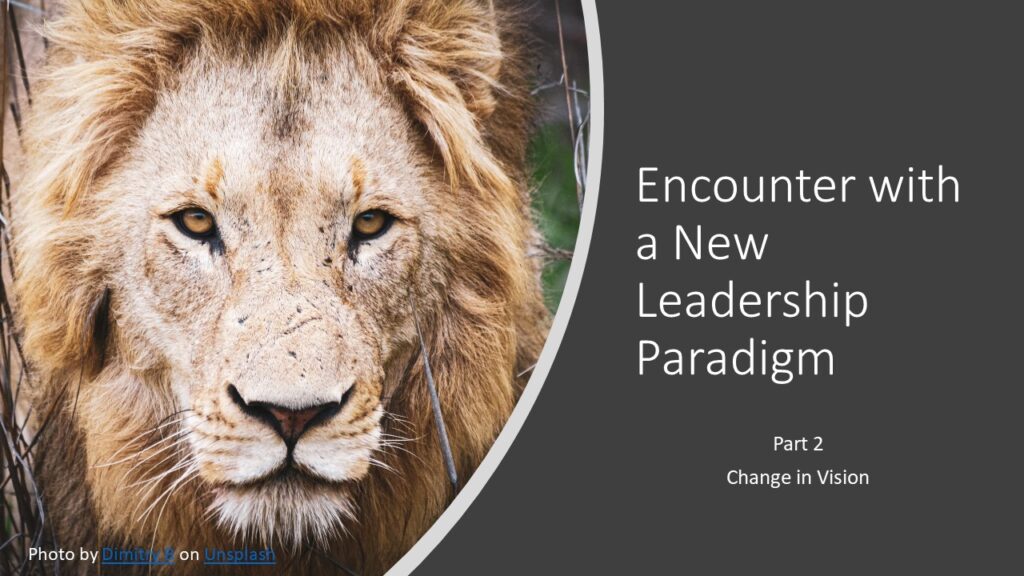
If you follow current discussions on Businesses, you cannot miss the debate over Purpose, People and Profits. Sometimes it is one against the other, other times it is about balancing the three.
Traditionally business was about profits, or to use a broader term, wealth creation. This traditional understanding of business is being questioned now. A car requires fuel to take us from point A to point B, but none of us buy a car to just fill in fuel and keep it in the garage. We need to breath to live, but none of us will say that breathing is the very purpose of life. All of us understand that wealth is an integral part of business, but that does not mean that it is the purpose of business.
The bottom line is this, businesses need to have a higher purpose. A purpose that is for bettering the conditions of humanity. No one disputes the fact that businesses will and should make money while solving the problems that humanity faces today.
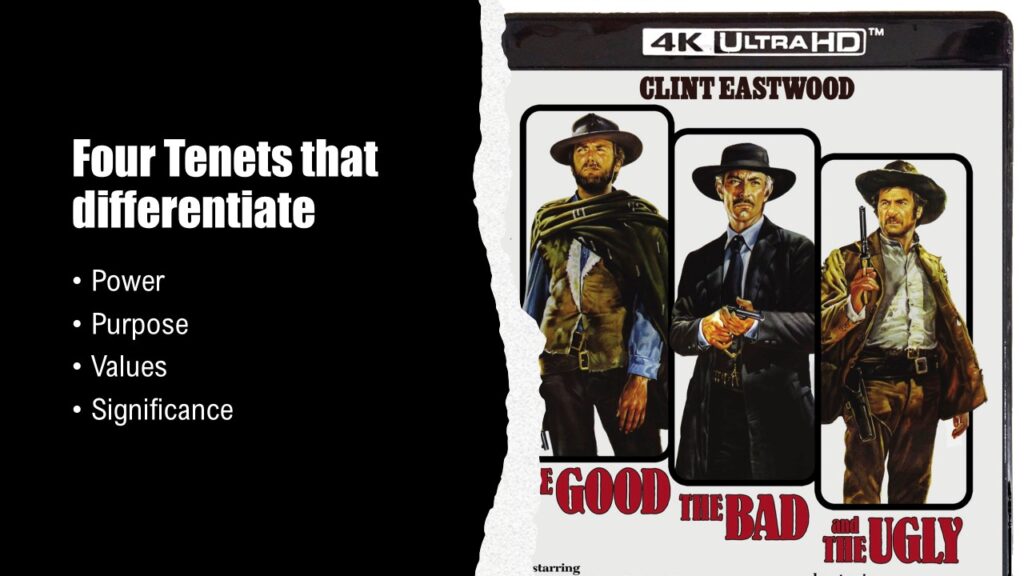
Purpose is one of the four tenets that differentiate the good , the bad and the ugly of leadership. I had written about the four tenets in my earlier blog (https://leadyne.com/encounter-the-four-tenets) , the other three being Power, Values and Significance. Purpose is a key part of vision, sometimes purpose is the vision in itself. It answers the question of why are we here? Why does the organisation exist? . Ken Blanchard and his co authors say rightly
Leadership is about going somewhere. If you and your people don’t know where you are going, your leadership doesn’t matter.[1]
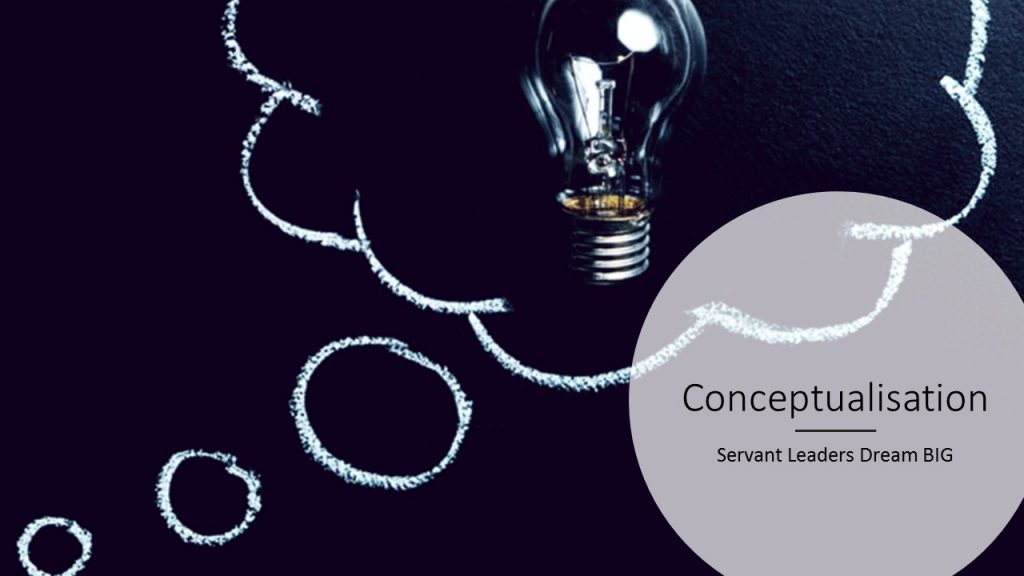
Setting the right vision requires a right leadership philosophy. An encounter with the Servant Leadership paradigm will transform the way you as a leader, and your organisation looks at vision. Servant Leadership is often seen (and dismissed) as an oxymoron. As described in my earlier blog (https://leadyne.com/dcs) this is far from truth and the ability to conceptualise, and dream big of a perfect future is what makes Servant Leadership a reality. This is the first behaviour that we study and measure in our DEEP BHC framework. This behaviour called Demonstrating Conceptual Skills is defined as;
Dream Bold and BIG. Participate in, and contribute to, creating a higher order purpose and an unconstrained vision for the organization. Transform a ‘What is’ frame of mind to ‘What if?’
An encounter with the Servant Leadership Paradigm will bring the visioning behaviour as a culture at all levels. Apart from enabling leaders to set a higher purpose vision for the organisation, a culture of Servant Leadership enables vision setting at all levels in the organisation. There is a myth that the vision can be only at the organisational level. The fact is the contrary. A vision can and must exist at all levels of the organisation. Of course, there is a need for the visions to be aligned. The “Demonstrating Conceptual Skills” behaviour of the DEEP BHC framework (https://leadyne.com/measuring_sl) makes this aspect measurable and hence developable.
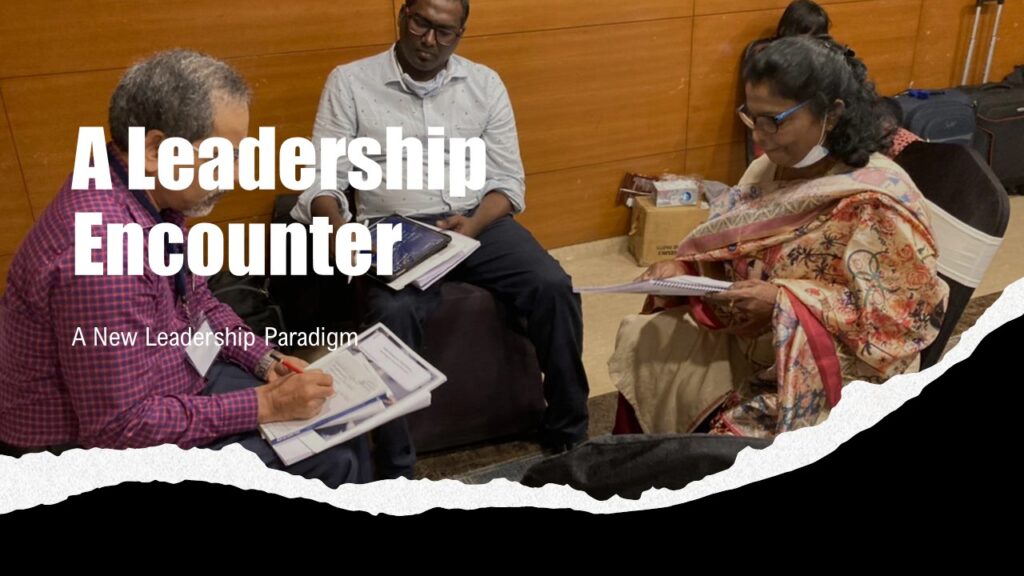
An encounter with Servant Leadership paradigm will make your vision for yourselves and the organisation an energizing one. When the organisation has a higher purpose than making money, a vision rooted in bringing significance to the world we live in, it will energise people. An example is found at UST (https://ust.com) where the purpose is “Transforming Lives”. Such higher purposes will help employees rally around the vision. On the contrary, when the organisation has an inward looking vision, the employees are forced to rethink on their association with the organisation. To be the #1…, to be the xxx of choice.. etc are inward looking statements that do not inspire employees working in the organisations.
Lastly, an encounter with Servant Leadership paradigm will make sure that the profit motive is achieved automatically. Ken Blanchard says
Profit is an applause you get for taking care of your customers and creating a motivating environment for your people.[2]
One of the first thing that leaders can do to engage and motivate employees to give them a purpose. A purpose higher than creating wealth or becoming #1 in their business. Yes, you read it right!! Leaders can give a purpose for employees. McKinsey research shows that COVID 19 has prompted several employees to reflect on their life purpose. More importantly, they expect the organisational purpose to help them fulfil their life purpose.[3] Naina Dhingra of McKinsey says,
One of the things that we were surprised to find in the research is that about 70 percent of people say they define their purpose through work. And, actually, millennials, even more so, are likely to see their work as their life calling.[4]
And the benefit extends to bottom line as well. McKinsey research establishes a positive correlation between purposefulness of employees and their EBITDA.[5]
As a leader you have the responsibility of ensuring a higher purpose for your organisation. Have an encounter with Servant Leadership. It will change your vision for good. And for the good of yourselves, your team, your organisation and the world.
_______________________________________________________
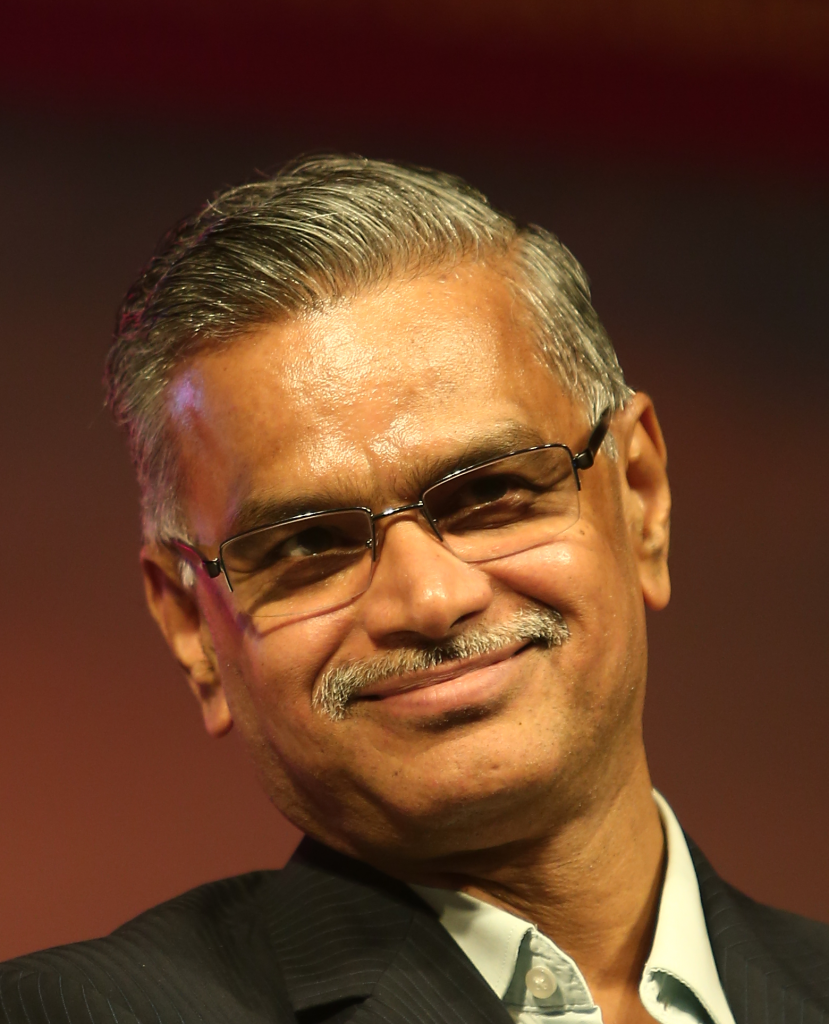
Dr. Madana Kumar is the Servant Leadership Evangelist at UST. You can connect with him here or contact him here.
[1] Jesse Stoner, Ken Blanchard and Drea Zigami. Leading at a Higher level. Blanchard on Leadership and Creating High Performing Organisations. Chapter 2. Blanchard International. 2010. Pp17
[2] Don Carew et al. Is your organisation High Performing? Leading at a Higher level. Blanchard on Leadership and Creating High Performing Organisations. Chapter 1. Blanchard International. 2010. Pp3
[3] Naina Dhingra, Andrew Samo, Bill Schaninger, and Matt Schrimper. Help your employees find purpose—or watch them leave. April 5 2021. McKinsey and Company. Accessed at https://www.mckinsey.com/business-functions/people-and-organizational-performance/our-insights/help-your-employees-find-purpose-or-watch-them-leave on 5 Aug 2022.
[4] Naina Dhigra. The Search for Purpose at work Podcast. June 3, 2021. McKinsey and Company. Accessed at https://www.mckinsey.com/business-functions/people-and-organizational-performance/our-insights/the-search-for-purpose-at-work on 5 Aug 2022.
[5] Naina Dhingra, Jonathan Emmett, Andrew Samo, and Bill Schaninger. Aug 18, 2020. Igniting individual purpose in times of crisis. McKinsey and Company. Accessed at https://www.mckinsey.com/business-functions/people-and-organizational-performance/our-insights/igniting-individual-purpose-in-times-of-crisis on 5th of Aug 2022.

The future of work has been a hot topic of study for the past several years. The question that I would like us to ponder on today is the leadership philosophy that is best suited for the future of work. The future of work requires each one of us to have an encounter with a new leadership paradigm. What is this new leadership paradigm? In this blog we will examine one part of this encounter.
Studies reveal that the future of work will be more Hybrid pitting Remote working Vs. Traditional office. The concept of Gig workers or alternate works have been doing the rounds since early this millennium. Employees have a lot of choice in the future of work. Technology plays a a major role in changing the profile of the work, the worker and the workplace of the future. Employees are not happy with organisations that provide a great Employee Experience (EX). They are looking for great life experiences, which often transcend the boundaries of the traditional office. Engaging the employees requires constant innovation. Traditional ways through monetary means alone are not sufficient. The great resignation proved this point beyond doubt. Employees are looking for a holistic approach from their employers whether it be their well being or upgradation of their skills.
The role of leadership in meeting these new challenges cannot be overstated, or over emphasized. My studies reveal that there are four tenets that differentiate the good, the bad and the ugly of leadership of the future of work.

Power
I have discussed this in an earlier blog (https://leadyne.com/power-in-servant-leadership) . The fact is that leadership and power have always been bedfellows and not always the right way. While we acknowledge and accept the fact that there are several leaders who use power appropriately, the list of leaders who misused power is longer in the history of humanity and especially in business history. It is becoming increasingly clear that the employees of the future are not going to respect leaders who use power to further their self-interests. It is not the absence of power that differentiates. It is the conscious choice to use the power “with people” and “for people” as against “over people” that will different the good, the bad and ugly of leadership.
Purpose
The concept of “Purpose-over-Profit” might have sounded outrageous a couple of decades back. But not any more. Several business leaders are touting purpose as their focus. One of the recent HBR articles on Great Resignation[1] argues that mismatch of personal purpose with organisational purpose is a major cause of the Great Resignation. In short, while everyone agrees that money is required to keep a business running, making money cannot be the purpose of a business, just as filling gas in a car is the not the purpose for which we buy a car. Employees of the future are looking for organisations to pursue a higher purpose, a purpose that solves some problems that the current generation is facing or problems that future generations could face.
Values
Organisational values are an integral part of the culture of the organisation. More precisely how the leaders embody or demonstrate those values, defines the culture of the organisation. Employees f the future will not be satisfied by mere lip service to values or with just nicely farmed values adorning the wall so the corporate office or the websites. They want to see it in action. They want to see it embedded in the culture of the organisation. Absence of a strong set of organisational values and/or failure of leaders to translate such values in to observable workplace behaviours results in toxic culture. An MIT research into to topic reveals that toxic culture is by far the biggest driver of the Great Resignation[2]. Employees are looking for leaders who espouse a set of values in line with their personal values and moral standards.
Significance
Corporate culture has eulogized success disproportionately in the past, to the extent of downplaying collaborative work culture. Individual successes have been rewarded bountifully and this resulted in unhealthy competition within organisation itself. Employees of the future are not impressed by individual success of leaders. They are asking the question, what difference did that make to others? What difference did the success of a leader make to me? What difference did it make to the world? What difference will it make to the next generation. This is what I call as the “Life of significance”, that I discussed in my other blogs https://leadyne.com/4-personal-habits-2 and https://leadyne.com/four-reasons-why-servant-leadership-is-the-most-suited-leadership-philosophy-for-the-post-covid19-new-normal
These are the four tenets that we need to look at when we encounter the new leadership Paradigm for the future of work. Servant Leadership scores high on all these four tenets and thus becomes a viable alternative for the Future of work.
Come and embrace this leadership philosophy.
___________________________________________________

Dr. Madana Kumar, PhD is the Servant Leadership Evangelist at UST. You can connect with him here or contact him here.
[1] The Great Resignation or the Great Rethink?, by Ranjay Gulati, HBR Review March 22, 2022, Web accessed at https://hbr.org/2022/03/the-great-resignation-or-the-great-rethink on 9 June 2022.
[2] Donald Sull, Toxic Culture Is Drivingthe Great Resignation, MIT Sloan Management Review, Jan 11, 2022 . Web accessed at https://sloanreview.mit.edu/article/toxic-culture-is-driving-the-great-resignation/ on 20 Jan 2022
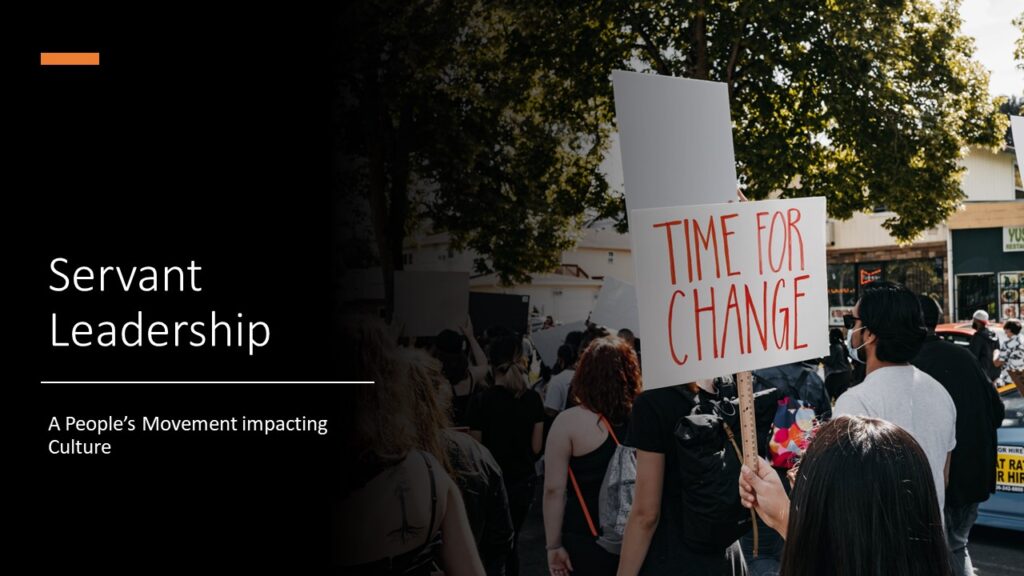
I am often asked what the biggest hurdle for implementation of Servant Leadership in an organisation is.
Of course, we must first get through the first hurdle of leadership-buy-in for the concept itself. This task is made difficult by the amount of myths that exist around the topic. However, once we get through this hurdle, there are still serious mistakes organisations make while driving its implementation.
Traditionally L&D or Leadership Development organisations focus on building skills. More mature L&D organisations move up to preparing employees for specific roles. While these two are essential, the problem is when we stop at these. My experience is that if we approach Servant Leadership at a skill level or if we use it only to prepare leaders for their leadership roles, the program is likely to fail and at best will have limited impact. Servant Leadership needs to be addressed at a culture level. This is where the challenge comes in. L&D or Leadership Development organisations think that culture is not within their scope and generally stay away from interventions that build culture. That is why there is a strong case for integrating other Organisational Transformation efforts with the Servant Leadership drive.
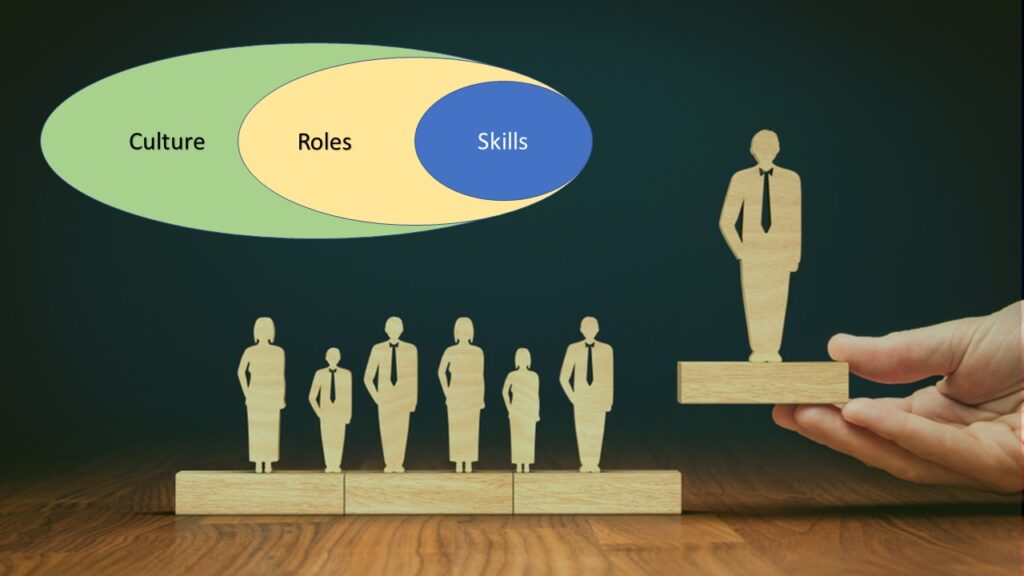
One of the ways this can be done is to ensure that all other systems and processes like Performance Management, Rewards and Recognition, Feedback mechanism, Goal setting, Learning Policy, Career Frameworks etc are all aligned to this principle.
A more important aspect of this integration is to ensure that the implementation of Servant Leadership is not left to the L&D and/or Leadership development functions within the organisation. It has to be made into a people’s movement.
This is best achieved by creating passionate champions within the organisation who will go out of their way, who know the impact of the program, who speak up for the philosophy, who have experienced an impactful change in themselves, and who are more than willing to invest their time in teaching this philosophy to others. Such Champions need encouragement and enablement.
This is where a structured Certification process becomes necessary.
UST is one such organisation that has embraced this philosophy and is successful in its implementation at a culture level through a network of dedicated Champions from businesses. This group of Champions go through a strenuous but deeply fulfilling Certification process and become Certified Servant Leadership Champions (CSLC). It is through such CSLCs that UST is able to make this a culture, a fact that has been acknowledged by external auditors like Top Employers Institute (TEI).

Certified Servant Leadership Champions (CSLC) see a sea shift in their own leadership and life philosophy. Many see significant transformations take place in their personal lives. The CSLCs are also well equipped to take the message of Servant Leadership across the organisation, thereby making UST be successful in employee centricity and organisational results.
Come and consider being certified in this philosophy and become a champion of a cause that will benefit organisations and can create a better world.
____________________________________________________

Dr. Madana Kumar, PhD is the Servant Leadership Evangelist at UST. You can connect with him here or contact him here.
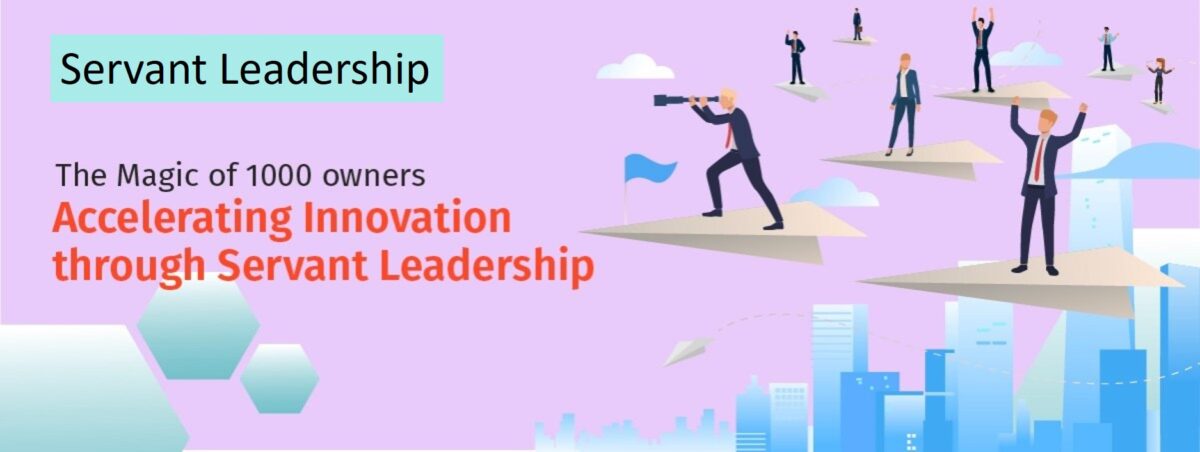
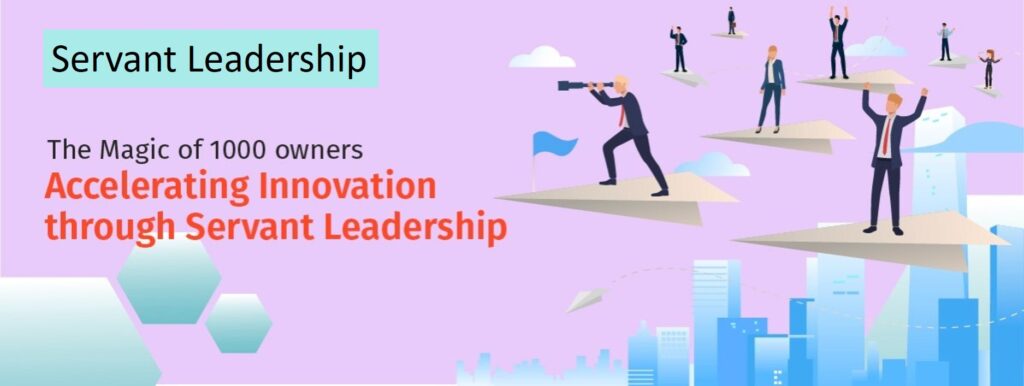
It is a well-accepted fact that large enterprises struggle to innovate. It sounds ironic, right? Large enterprises have a lot more brains and if the creative powers of those brains are tapped effectively, why should they struggle with innovation? The fact is this. It is not the lack of ideas that kill innovation in large enterprises. Then what does? Let us try to find out answers to this question.
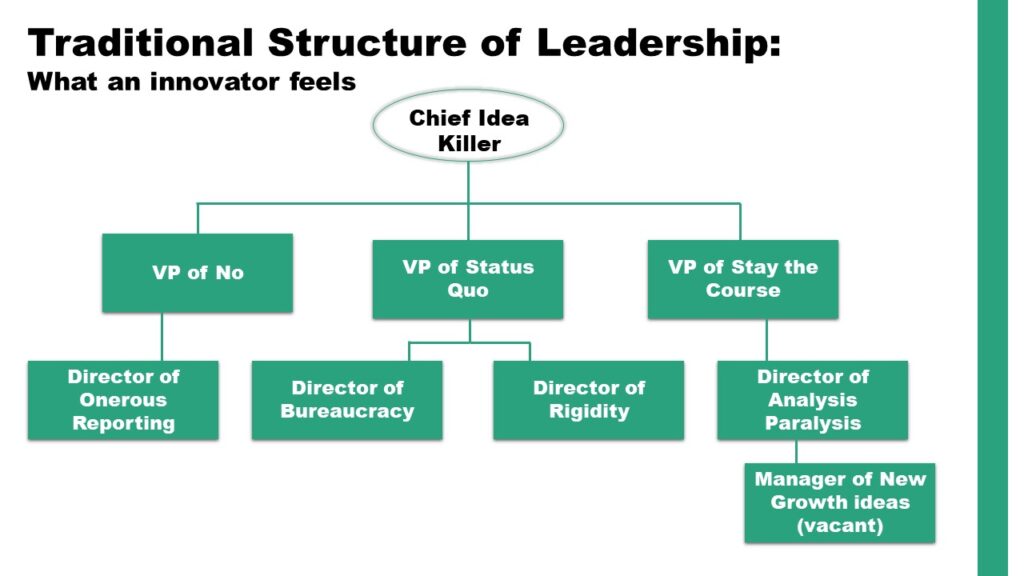
So is it possible for large enterprises to become innovative. It certainly is. That is where the concept of a 1000 owners kick in. What if all the employees behave as good stewards of the organisation, and do not see themselves as merely “resource” to fulfil an organisational goal? This requires a very different Leadership Philosophy and a different culture. It is possible through Servant Leadership, a leadership philosophy that comprehensively addresses the problems described above.
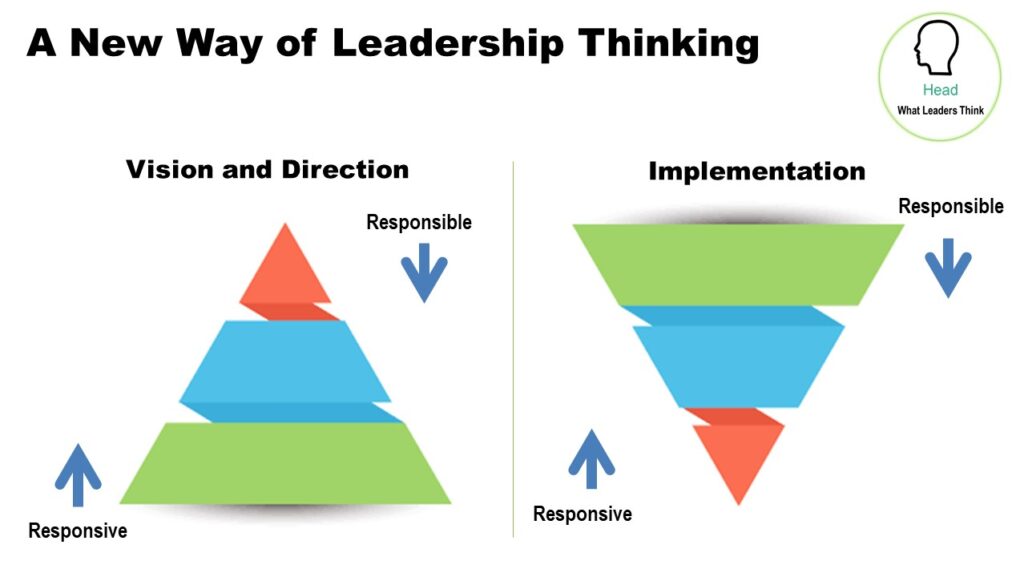
What this effectively does is to give freedom and empowerment to the traditional bottom of the pyramid employees, while the leaders remain available to them as “resources”. This enables them to look at the clients and consumers rather than their bosses. In turn, they are able to see, understand and resolve clients’ problems in the most creative way. The inverting of the pyramid also ensures that ideas do not need to flow up the hierarchy to get implemented.
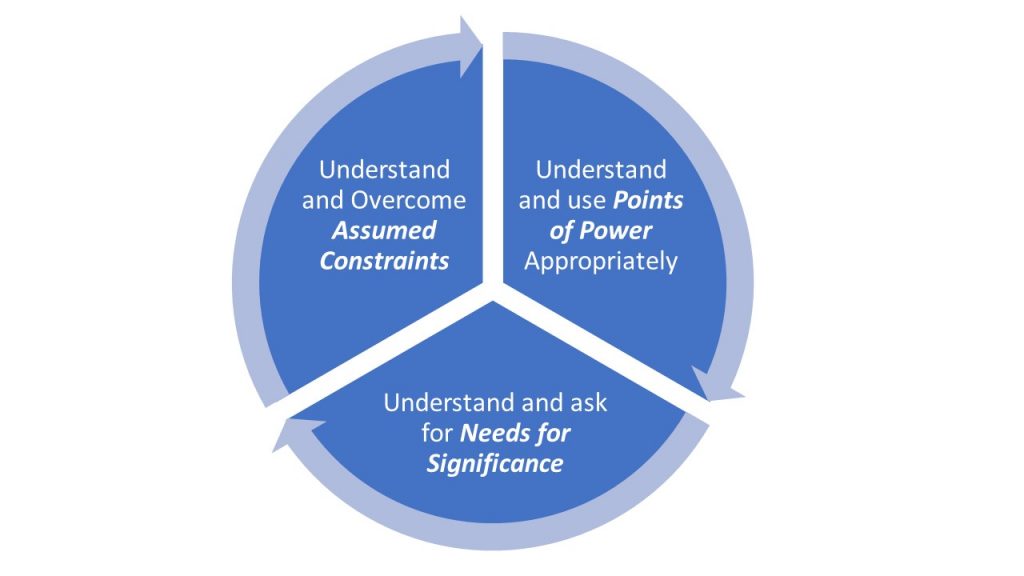
Do you want to experience the magic of 1000 owners? Embrace Servant Leadership and you can see the difference.
_________________________________________________________

Dr. Madana Kumar, PhD is the Servant Leadership Evangelist at UST and Leadyne. You can connect with him here or contact him here.
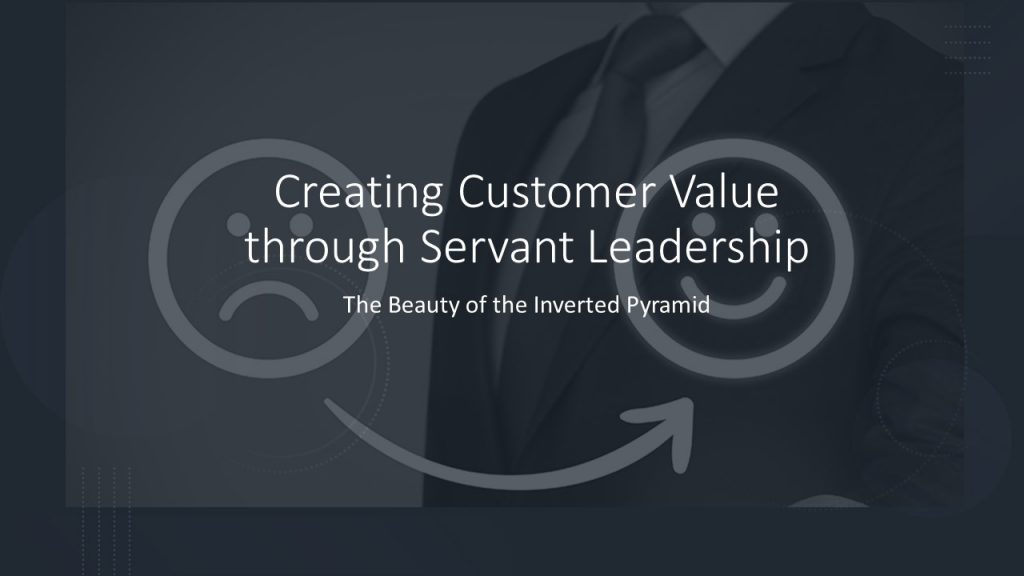
Creating Customer value through Servant Leadership
‘This is ridiculous!’
Very often this is the thought that runs in our head, sometimes even speak aloud – as we run into a wall trying to get a solution, process a claim or service something
The service person gives you a vibe which could mean any of the following
“I need to play it safe about my job. Your pain comes next if at all”
‘The person who issued this would have told you’
‘This is what the system says..’
‘Let me call my manager’ ( I know he can’t do anything about this either!)
One gets the feeling that the ‘house always wins’ and now I have to pay more or convince more people to solve the problem’. As a customer, there is a sense that you have been denied what is rightfully yours. Ken Blanchard calls it the duck syndrome, where everyone who you contact in the hierarchy says quack, quack, and pushes it to the next level up.
How does it happen?
Organizations want to reduce variability of responses in the final mile.
Systematized response ensures predictability of the cost of business or service and guards against any potential exploitation. Organizations believe that all admissible responses to a customer have to pre-exist in the defined manual.
Over time this codified customer interaction actually ‘trims’ away the grease of good customer service and adds to the cost of business and risks losing customers. Good Customer service relies on the intrinsic human quality of empathy and the willingness to help resolve any genuine and logical issue in the best possible manner.
Perceived lack of ownership and the capability question
Most pyramidal hierarchies believe that the level of ownership and decision making capabilities is weak at the lower rungs. Therefore actions have to be guided and clearly defined for the organization to be successful.
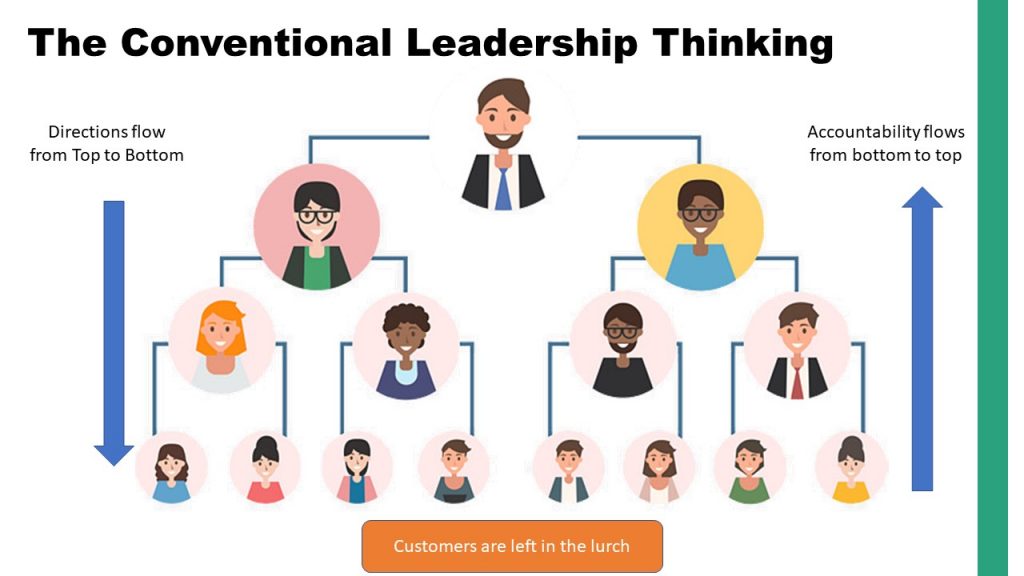
Not true.
Many organizations have generated phenomenal customer value with a distributed model of individual or team ownership. Google would not be in a position to conceive and pursue so many ‘moonshots’ if there were no microcosms of risk taking, experiment and accountability. Southwest airlines pride themselves in empowering employees to do what is right. Ritz Carlton creates a culture where any employee will say “I will take care of it” immaterial of which function the problem belongs to.
The Fear Factor
Organisations end up creating a culture of fear, that if the processes are not followed to the letter, their jobs are at risk. So instead of trying to “serve” the customer, employees are obsessed about following the written down procedures and policies. Added to this, a leadership which thinks that “they know the best” do not ever ask for feedback from the people who are actually dealing with the real stuff. Of course, no one dares to volunteer feedback because of the fear factor.
Servant Leadership as a lever of resolution
Servant Leadership behaviour is defined as a set of 7 unique behaviours called DEEP BHC and it is a measurable and actionable process. It helps create an idea generative organization, a reductive approach to processes that enhances speed of response, and thoughtfulness that improves customer delight
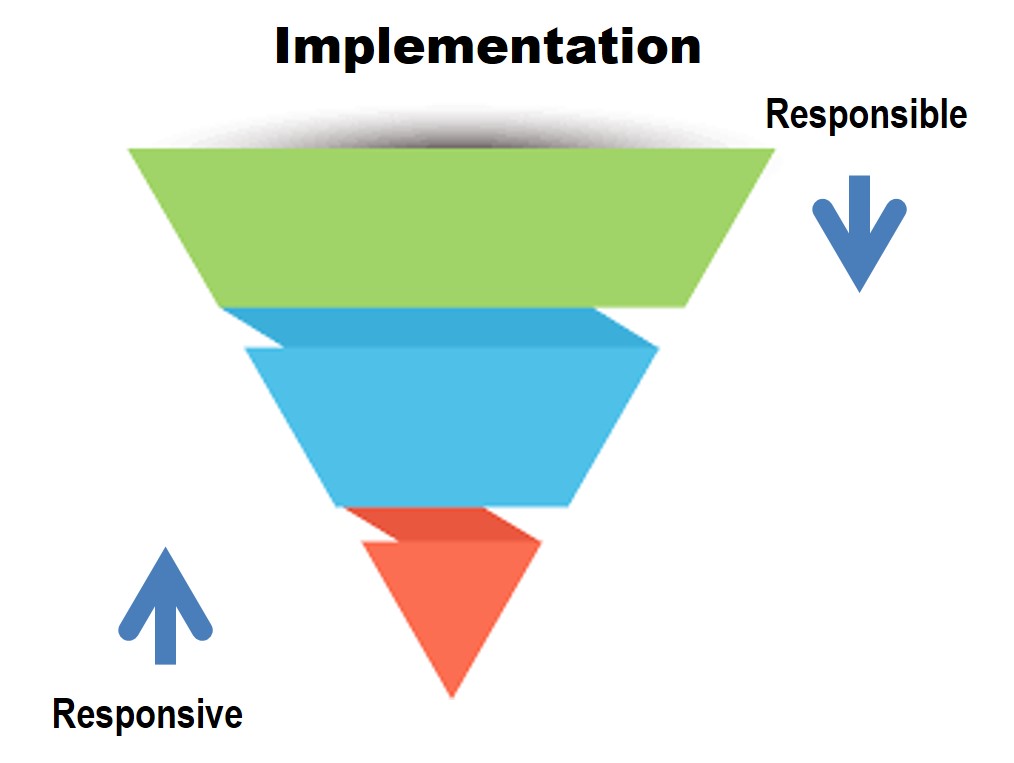
Servant Leadership recommends that organisations invert the traditional pyramid and let the employees at the “bottom of the pyramid” do what is best when it comes to customer issue resolution. Two specific behaviors of Servant Leaders, mentioned below, can help build ownership and enhance customer value through better engagement and service
Empowerment:
Building the confidence that all employee feedback is welcome and will receive a thought through response from the organization.
Recognizing that people are capable of decision making and it is most likely in the interest of the organization
Creating some wiggle room for decision making, that is not codified. Let the employees know that every situation cannot be codified and employees can use their grey matter based on the situation, as long as it is in line with the organisation’s vision, mission and values. Encouraging peer learning from customer feedback and encouraging response in real time.
Helping others grow and succeed:
Success for the frontline executive is about making themselves and the organization look good in the eyes of the customer.
Taking a holistic approach to their (frontline) development and not viewing everything through the lens of revenue alone can be a key differentiator for the leader and the organization.
Encouraging them to ask questions and find answers, training them to build not just their service acumen but also their business acumen, creating an atmosphere that encourages initiative and acknowledges effort, are some aspects that will make them well rounded contributors.
According to a research paper by Robert Saxe and Barton Weitz on a ‘Measure of the customer orientation of salespeople’, Salespeople with higher levels of customer orientation truly care about customers, and thus engage in actions that customers value, such as listening to customer feedback and solving customer problems. Salespeople who demonstrate higher levels of adaptive selling adjust their sales strategies in ways that better fit customers’ needs and preferences (Spiro and Weitz 1990). Together then, customer orientation and adaptive selling lead to win-win outcomes because customers are served in better, more individually relevant ways, producing higher levels of success for the sales force and the organization.
A flip on the traditional leadership model, Servant Leadership invigorates people at various levels through trust and care, and by default inculcates better ownership and accountability. It is an approach that has been successfully implemented by organizations who have ‘flipped’ conventional thought and built successful and robust businesses. Google, Starbucks, Southwest Airlines, Tatas to name a few.
(An edited version of this This article also appeared in the Enparadigm Blog in June 2021 You can access the article here.
_____________________________________________________
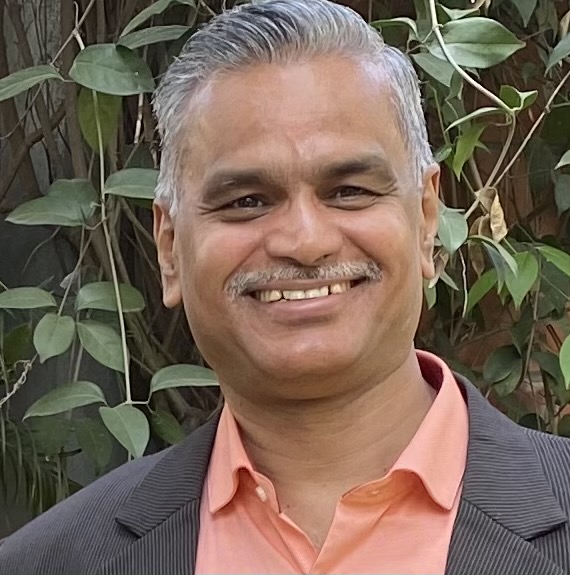
Dr. Madana Kumar, PhD is UST’s Servant Leadership Evangelist. You can connect with him here or contact him here.
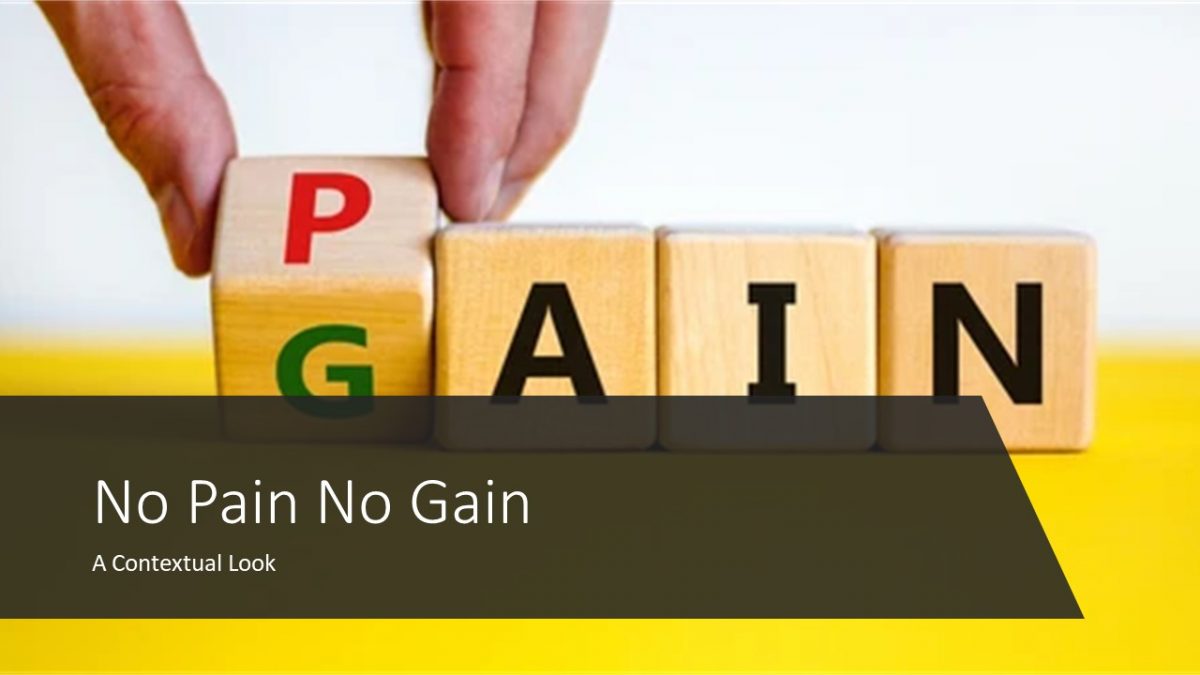
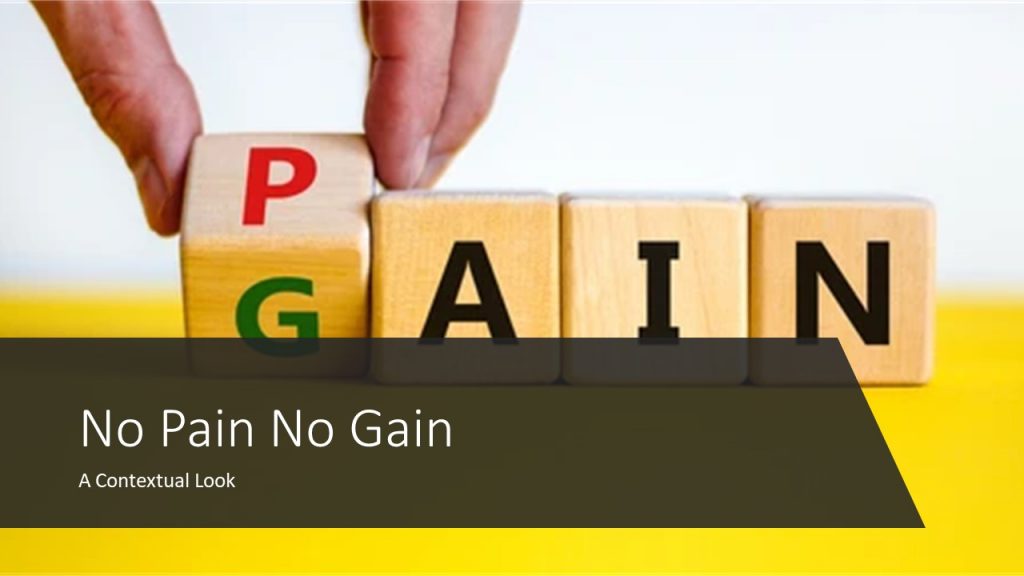
We all have heard the proverb “No pain No Gain”. I am not sure if you have given it much thought. But if we give it a thought, we might have differing opinions about it. In the context of doing hard work to progress in life this sounds great. But how do we apply this or translate this in the current context of the pandemic, where we have lost our loved ones, or lost our livelihoods? How do we react when we go through suffering and mental pain for no apparent fault of ours and for no apparent gain that we can foresee soon?
I must confess that I have no answer for those questions. But what I would like to attempt to do is to examine this aspect of pain and suffering and see how we can cope with it better.
In an earlier blog, I discussed the victim mentality that some of us get into when faced with pain and suffering. We ask questions about why me, why now etc, and feel defeated and stay defeated. That is certainly not going to help anyone. So what can we do when we are going through pain and suffering? I offer two suggestions that can turn around our reaction to pain and suffering.
Arthur Ashe was the first black man to win a Grand Slam. He is believed to have got infected with HIV/AIDS during a blood transfusion during a surgery. When it became known, people all over the world started asking questions on why him? The questions reached him and his response was this.
“The world over — 50 million children start playing tennis, 5 million learn to play tennis,
500,000 learn professional tennis, 50,000 come to the circuit, 5000 reach the grand slam,
50 reach Wimbledon, 4 to semi final, 2 to the finals,
when I was holding a cup I never asked GOD ‘Why me?’.
And today in pain I should not be asking GOD ‘Why me?’ ”
Happiness keeps you Sweet,
Trials keep you Strong,
Sorrow keeps you Human,
Failure keeps you humble and Success keeps you glowing, but only Faith & Attitude Keeps you going..”
2. Consider Pain as Gift
No, you didn’t read it wrong. I mean it. It is a gift that tells us where to draw the lines and how to enjoy the pleasure of life responsibly. Let me illustrate this with a medical study.
Dr Paul Brand (1914-2003) worked amongst and studied leprosy in India. He establishes the fact that what lepers suffer with most is not because of the decease per se, but because the decease acts as a very very strong anesthetic and takes away their sensation of pain. They cannot feel pain and thus they end up hurting themselves (without feeling anything) repeatedly. They put their hands in fire because they cannot feel the heat. They walk on broken glass because they cannot feel the pain when glass pierces their feet. Even common activities like holding a mop or turning a key, or working with a screwdriver could damage their skins and muscles, because they just cannot fathom how much pressure to put on those things. Simple shoes can cause infections because they do not know when the shoe hurts and causes bruises. Imagine a nail piercing your foot when you walk and it is staying there, and getting more and more deep into your flesh because you did not feel the nail piercing your foot. Imagine not being able to itch when a mosquito bites you, imagine waking up with your toe missing, because a rat chewed it off and you didn’t feel a thing. It is difficult for you and me to fathom this, because we take these things for granted. And we are able to take these things for granted because we can feel pain. Pain helps us to stop doing things that could damage us more permanently. Pain warns us to stay away from activities that could be harmful. Pain tells us when to stop. That is why Dr Brand boldly states “Thank God for inventing Pain. I don’t think He could have done a better job. It is beautiful.”
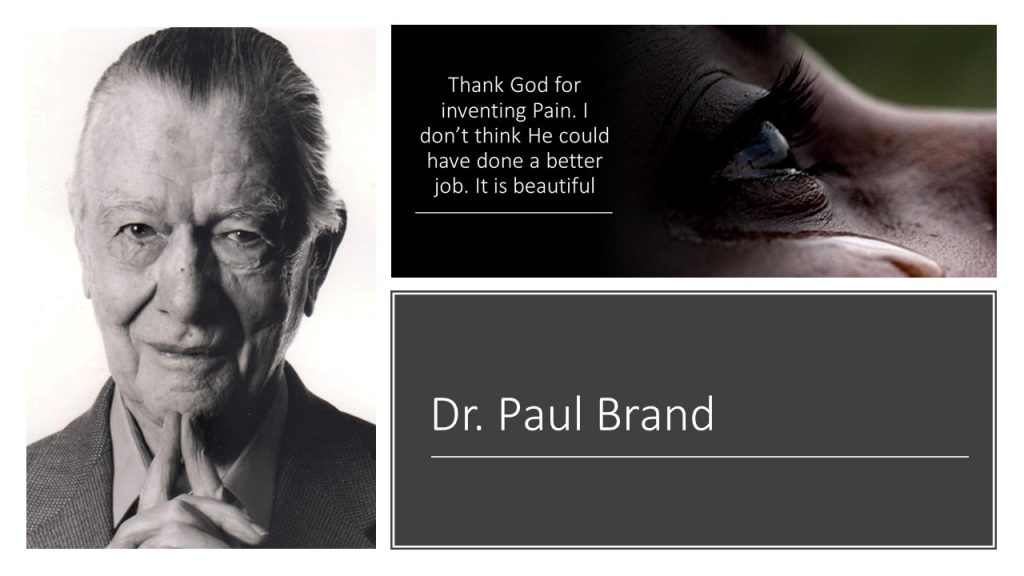
Dr. Brand knows the value of pain, because he raised and spent millions of dollars to design and manufacture gadgets like special gloves, special shoes, special audio devices etc, to enable lepers to be able to “feel” pain artificially.
Are we ready to use pain and suffering for developing an attitude of Gratitude? Can we consider pain as a gift given to us? Servant Leaders are able to cope with pain and suffering better, because of the behaviour of Emotional Healing that I wrote about in an earlier blog. Servant Leaders put the need of others above their own, as we discussed in a previous blog on putting others first. So instead of focusing on their own pain and suffering Servant Leaders focus on others pain and suffering and ask the question “what can I do to alleviate someone else’s pain today?
What is your response going to be? Join the Servant Leadership Movement, manage your pain gainfully and help others manage their pain.
____________________________________________________

Dr. Madana Kumar is UST’s Servant Leadership Evangelist. You can connect with him here or write to him here.
Let Love be our first priority
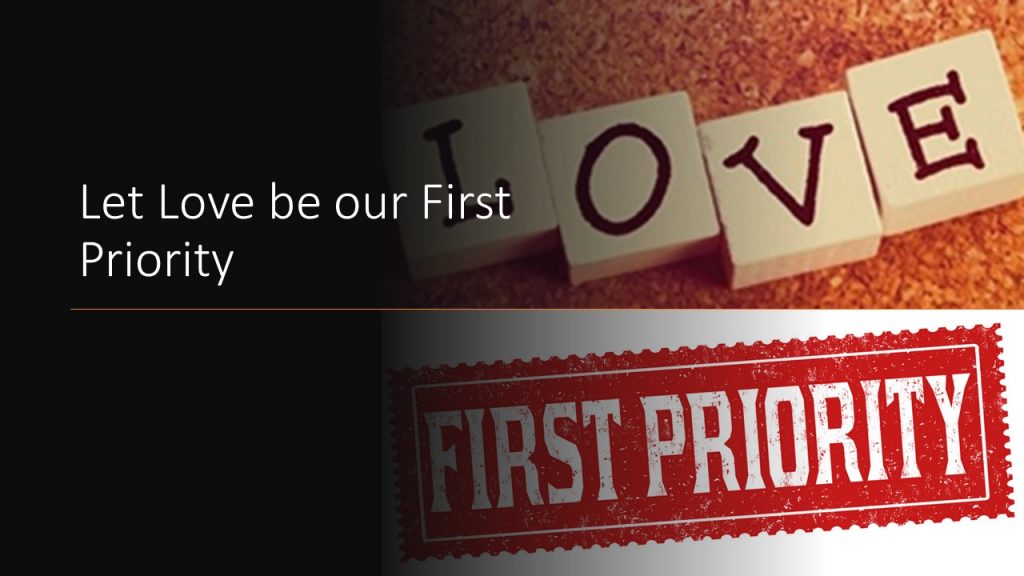
These are troubling times for all of us. Several of us are perturbed by the pain and suffering that is going on. Where can we go for comfort? Where can we find solace? How can we comfort others?
You must have heard the saying “ You can’t live on love and fresh air alone”. The underlying assumption behind this saying is that they are the only two things that are available free. Let us look at it in the context of today. Newspapers and social media are full of heart wrenching stories of people gasping for oxygen, something that is supposed to be available freely in fresh air. The air pollution in Delhi, India, for quite a number of years have taught us that we cannot take fresh air for granted. COVID has just reaffirmed that. We cannot take fresh air for granted.
How about love? Is it free anymore? Is it available when we need it the most?
Whatever your answer is for this question, the good news is that each one of us can make an effort to make the answer positive for others. Yes, if we turn around the question to “Do we love freely anymore? Is love our first priority in life? “ The picture will change for sure.
I define Servant Leader as “someone who invests in the life of another person to the extent that the other person becomes better, bigger, wiser, richer, healthier, wealthier, happier, more famous than the leader themselves.”
This should not be limited to formal leaders. This can be applied to each and everyone of us, immaterial of whether we hold a formal leadership position or not. Let me suggest a few practical things we can do to take our love to this level
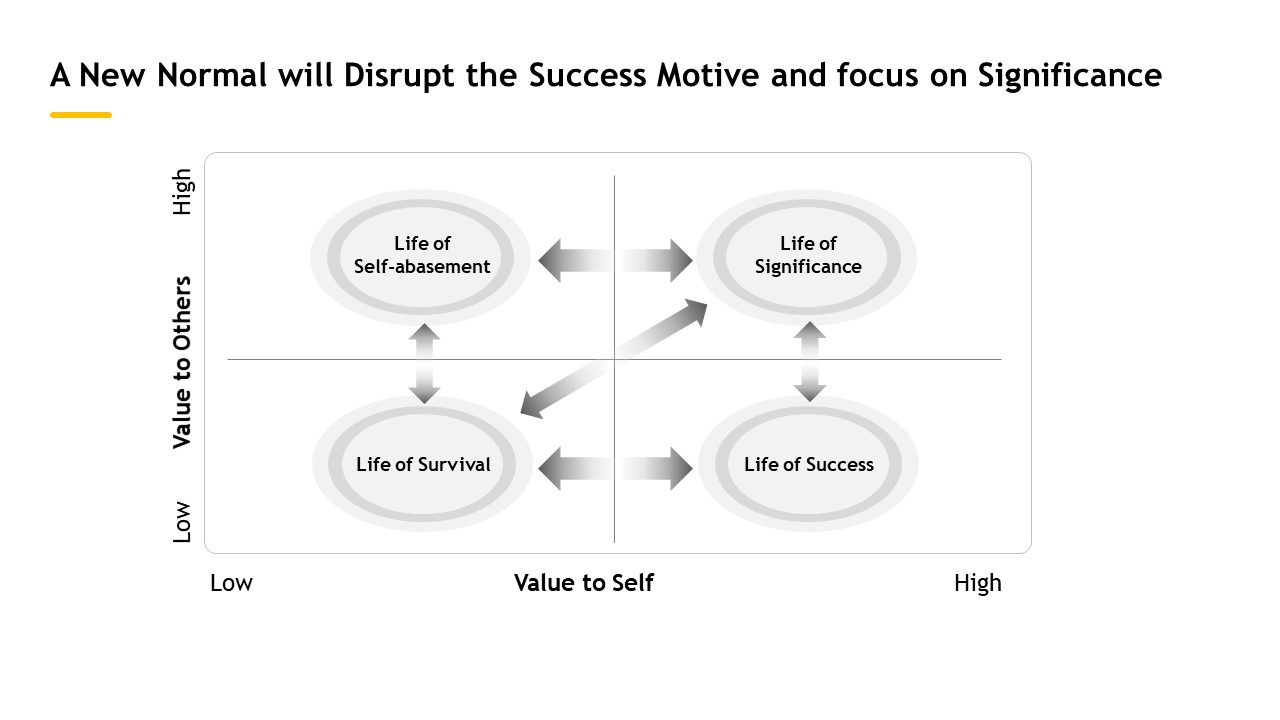 Significance is when we use our success to add value to others. When we use our wisdom to lift up the foolish, when we spread our knowledge to educate the unlearned. When we use our wealth to help the poor, when we use our health to care for the sick, when we use our network to be able to help someone in need get the precious gift of an oxygenated bed when they most need it. If we just chase success alone, we will forget the people around us, and will be very busy achieving things one after another . but will not have time and inclination to use anyone that for someone else’s benefit.
Significance is when we use our success to add value to others. When we use our wisdom to lift up the foolish, when we spread our knowledge to educate the unlearned. When we use our wealth to help the poor, when we use our health to care for the sick, when we use our network to be able to help someone in need get the precious gift of an oxygenated bed when they most need it. If we just chase success alone, we will forget the people around us, and will be very busy achieving things one after another . but will not have time and inclination to use anyone that for someone else’s benefit. I spoke about the little child who could not see the festivities around her till the time the father decided to lift her up above him. There are a lot of souls around us today who need that uplifting. Smile at someone. Ask another person, how you can be helpful. Just lend a listening year to someone who needs to pour out their troubles. Mourn with someone who lost a loved one. Pray for them. Provide for them as much as you can. Don’t let distance and lockdowns hold you back.
I spoke about the little child who could not see the festivities around her till the time the father decided to lift her up above him. There are a lot of souls around us today who need that uplifting. Smile at someone. Ask another person, how you can be helpful. Just lend a listening year to someone who needs to pour out their troubles. Mourn with someone who lost a loved one. Pray for them. Provide for them as much as you can. Don’t let distance and lockdowns hold you back.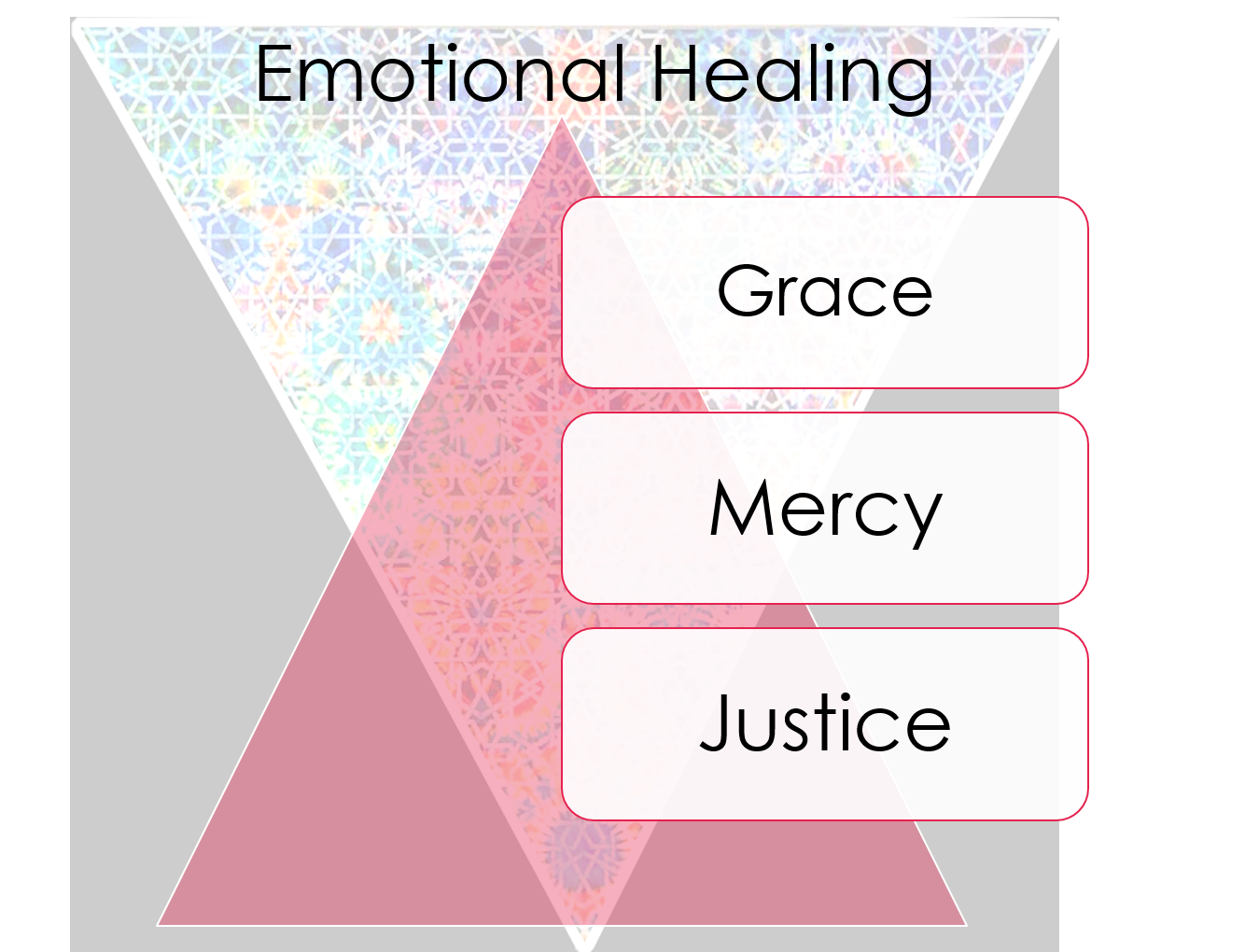 Don’t get caught up in the prison of unforgiveness and entitlement. Let us learn to let go and be willing to give others a second chance (and a third chance and an umpteenth chance). We are all messed up. Let us cut some slack for others to make their mistakes and learn from them.
Don’t get caught up in the prison of unforgiveness and entitlement. Let us learn to let go and be willing to give others a second chance (and a third chance and an umpteenth chance). We are all messed up. Let us cut some slack for others to make their mistakes and learn from them.And if you are working professional, start by rewriting your job description. If your job description is all about results, and goals and projects, it is time to rewrite the same to include love for your employees/ team members in your Job description. In the podcast Key Mental Shifts for Servant Leadership, by Pete Mockaitis, available in LinkedIn Learning and lunda.com, the presenter describes a case study in Walt Disney Parks. As all of us are ware, Disney prides themselves in providing a magical experience to all their guests. They started getting complaints that the housekeeping staff was being rude or not responsive to several Guests. The analysis revealed an interesting fact. The housekeeping staff’s job description was to keep the park clean. They were focused on their job description to such an extent that when they saw a client throw trash all around it made them antagonistic to the guests. And if a guest who was throwing trash on the road, comes and asks the housekeeping staff for directions, the natural response is going to be, “I don’t know, I am just a janitor.” They are thinking inside, “why I should I help this person, he just made my job harder by throwing trash on the road”. Once the leadership realised this, they changed the job description of the house keeping staff as “To create happy guests, to contribute to the happiness of our guests. How do you do that? Well, you provide them with directions when they need it. You give a kind smiling face when they ask you questions” and by the way, as an additional duty you also keep the park clean. This simple but definite switch to the Job description made a world of difference to the way the housekeeping staff treated the guests.
The message is this. Change your job description to something that you can look forward to. Add love to your job description. Make the first sentence “ My job is to take care of the people I am entrusted with, to care for their wellbeing, to motivate them, to develop them, to help them grow and succeed ”. Don’t worry about the HR drafted job description that might remain in the HR systems. Go ahead and change the Job Description that you will live every working day of your life. I guarantee you, your approach to your work and job will change significantly and you will find a lot more fulfilment in your job. And it will lift up several others on a daily basis.
Make love your first priority. Other results will follow.
_______________________________________________________
 Dr. Madana Kumar is your Servant Leadership Evangelist. You can Connect with him here and contact him here.
Dr. Madana Kumar is your Servant Leadership Evangelist. You can Connect with him here and contact him here.
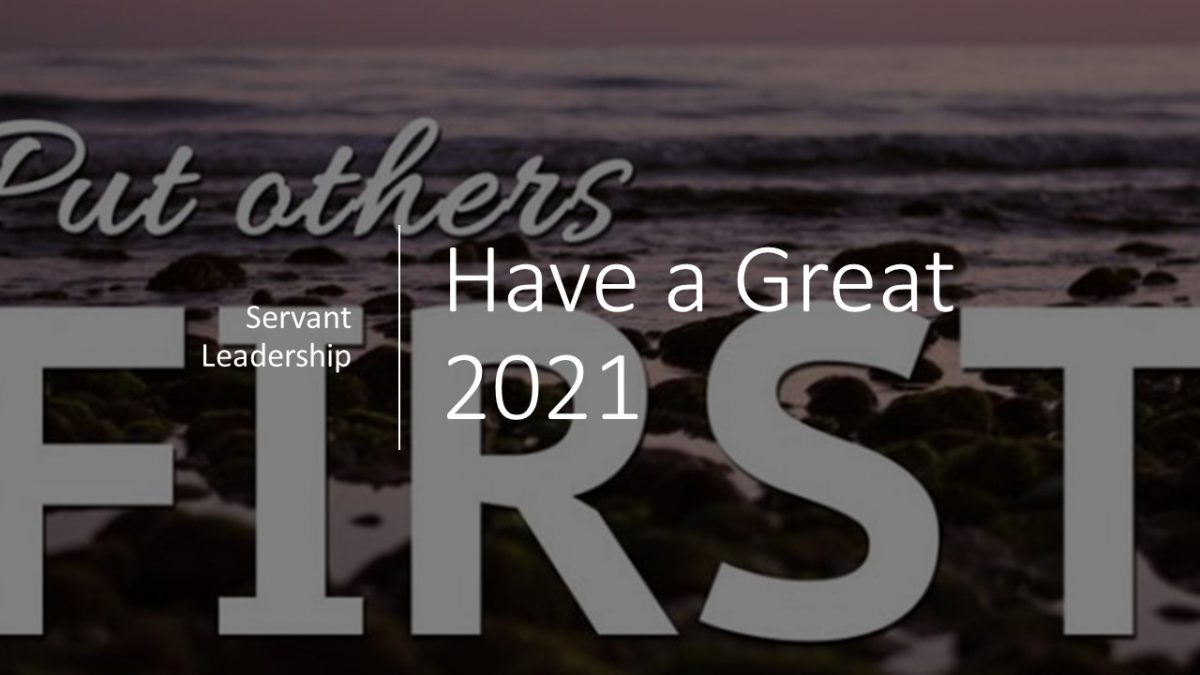
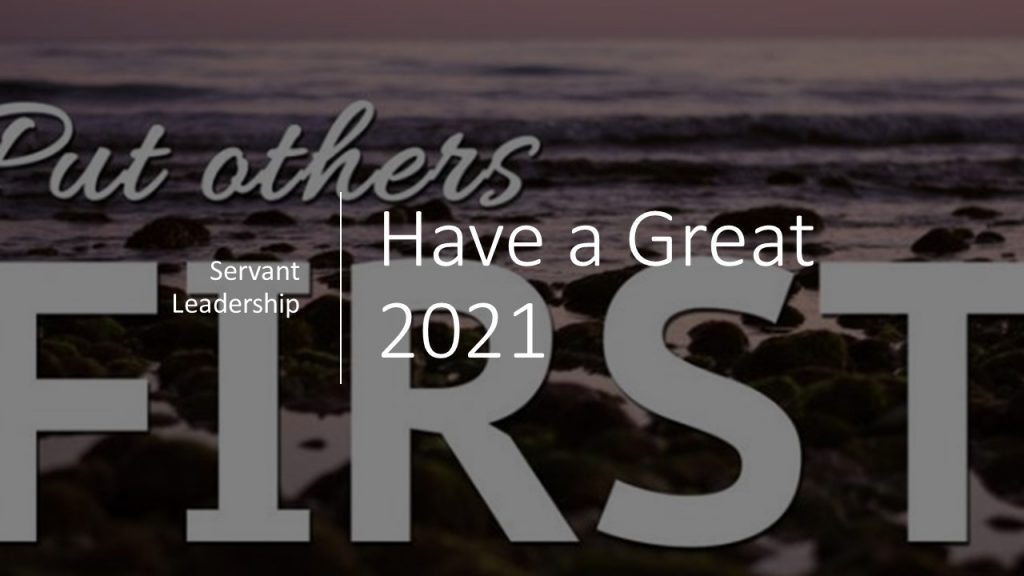
Permit me to ask you to do an exercise. Please do pardon me if you feel uncomfortable doing this exercise. Grab hold of a piece of paper and a pen. I would like you to think for a few moments and write down all the major things you did during this year of the pandemic. All of us had a difficult year and at the same time, the year has opened up opportunities for several of us. We have adapted to several things during the year. Write it down. It might be that your learned a new skill, you published a book, or It might be as simple as baking a cake, it might be buying cloths, it might be decorating the home or whatever. Think and write down please.
If you have finished writing it down, go through the list and put a tick mark on the items that were done for others. If you baked the cake for the family, it counts. If you bought cloths for your wife (if she ever allows you to do that; my wife doesn’t trust in my taste, and I admittedly do not have any, in cloths) it doesn’t count (I am kidding, it does). Now, look through the ticked items and identify what you did for your immediate family, immediate relatives, and put another tick mark against the items you did for people outside your family circle. Now sit back and reflect on the items that have the double tick marks.
The year has come to an end with the Christmas being over, Holiday Season coming to an end and a Grand Finale of the New Year celebrations. This is a season of Joy and celebrations, especially as we have bid goodbye to an arguably most difficult year this generation has faced.
All of you know that I evangelize Servant Leadership in corporates, and other Organisations. That is my passion, that is my mission and that is th legacy that I wish to leave. So, when people ask me to define a Servant Leader, I give them this definition. “A Servant Leader is someone who invests in the life of another person to the extent that the other person becomes better, bigger, wiser, richer, healthier, happier wealthier, more famous than themselves.” All participants in my workshops are impressed by this definition of Servant Leadership, but soon the “Practical aspects” of this definition starts raising its head. Does it mean that I will need to promote my direct report to be my manager? Does it mean that I give an increment to my team member that his/her salary becomes double that of mine? Practical questions. So, I do have a practical definition, and I do provide a practical definition, so that they don’t get put off by the ideal definition of Servant Leadership that I had articulated above.
But in this blog I want to intentionally keep away from the practical definition of Servant Leadership and ask that we embrace the concept of Putting Others First, in all its original intent. May this be our resolution for the new year. Putting Others First.
Putting Others First is one of the 7 DEEP BHC behaviours that I had written about in an earlier blog. . My research shows that this is one of the lowest scoring behaviours in the 360 degree survey that we run before our SLAM/ TSL (Transformation through Servant Leadership) workshops.
Let us look at a true story. The story is true, but some of the interpretations are mine in the narration that I have given below.
(You can refer to Kevin Carter’s Pulitzer Prize winning photograph of a Sudanese child and a vulture, https://en.wikipedia.org/wiki/The_vulture_and_the_little_girl#/media/File:Kevin-Carter-Child-Vulture-Sudan.jpg)

Several of you have seen this picture before. This is a picture taken by photographer Kevin Carter in 1993. This is a picture of a famine stricken Sudanese child who was trying to reach the UN feeding center just half a mile away. The child (initially published as of a girl, but later believed to be of a boy) was exhausted and could not carry on and the vulture was waiting for its feed. Kevin took the picture and the picture was published in the New York Times. The horror of the famine that was prevalent in Sudan came alive through this picture and this picture alone brought international attention to the situation in Sudan and significantly increased the donations for relief work in Sudan. Kevin Carter went on to receive the Pulitzer prize for this picture. But the story does not end there. Questions were asked about what did Kevin do actually, after clicking the picture. It is reported that he remarked to his wife that he did chase away the vulture. Yes, chase away the vulture but left the child where he was. Kevin did not think it was necessary, or possible for him to help the child reach the feeding center. The situation in Sudan was very volatile and they had limited time (it seems) and their priority was to click photographs. That was the job that Kevin was charted for. So he did his job (excellently) and certainly was rewarded handsomely for the great job he did. No one really knows for sure whether the boy survived or did really reach the feeding center finally. Kevin certainly did not know. The guilt and the horror of what he saw and what he did not do, weighed heavily on Kevin Carter and he committed suicide four months after receiving the Pulitzer prize.
This is a sobering story for us to remember this holiday season. In our hurry to celebrate the season, have we missed someone’s urgent need? In our eagerness to do a great job at what we have been assigned to do, have we missed noticing the need of another person? In our eagerness to protest against the restrictions we have had through the year about gathering, partying, worship, going to office etc, have we missed actions that could edify (build up) others? When we rejoice in healing that we or a loved one has received, or getting a promotion at work, or getting through a difficult situation, or provisions that received when we needed it the most, or whatever it is that we express our Gratitude for, have we paused and considered what did I do with that blessing to others?
I love this quote from Martin Luther, the 16th Century Christian Reformer. “If there is anything good in us, it is not our own, it is a gift of God. But if it is a gift then it is entirely a debt one owes to love. And if it is a debt owed to love, then I must serve others with it, not myself. Thus, my learning is not my own, it belongs to the unlearned and is the debt I owe to them. My wisdom belongs to the foolish, my power to the oppressed. My wealth belongs to the poor, my righteousness to the sinner. For these are the forms of God of which we must empty ourselves in order to be a servant. It is with all these qualities that we must stand before God and intervene on behalf of those who do not have them.” Even if you are not a spiritual person, this quote might resonate with you.
Before the spirit of relief (over 2020 being finally over) and the Holiday Season wears off this year, and before we get too deep into the new year , shall we make a commitment that we will Put Others First?
_________________________________________________________

Dr. Madana Kumar, PhD is UST’s Servant Leadership Evangelist. You can connect with him here or contact him here
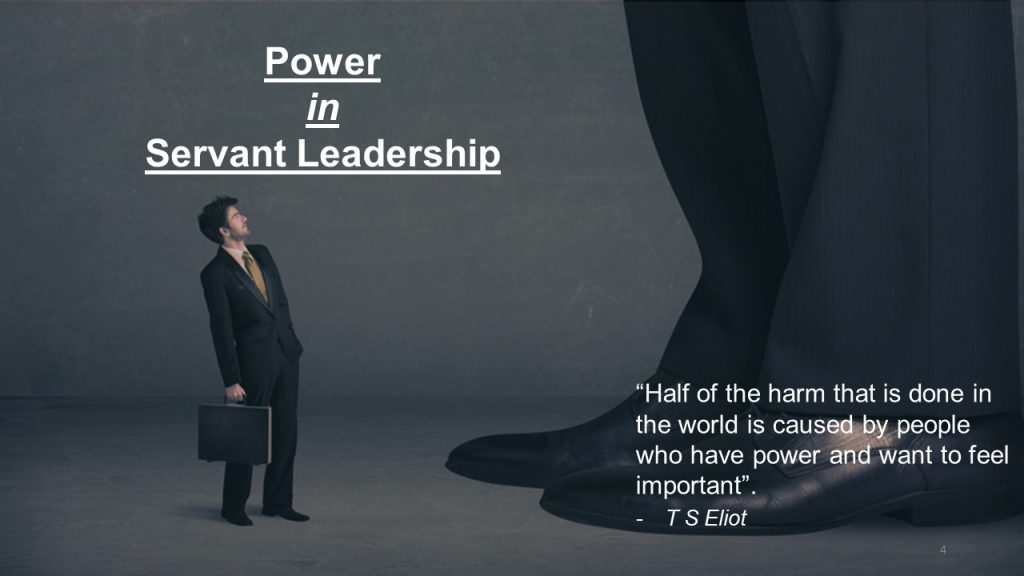
Leadership and Power has always been bed-fellows. We cannot think of one without the other. If we go with the definition that “Leadership is Influence”, then no one is really exempt from being a Leader. Does that mean everyone has some sort of power of otherwise? Researchers agree that we all have power, immaterial of whether hold positions or not. Social Psychologists John R. P . French and Bertram H. Raven conducted a remarkable study about power in 1959 and classified power into 5 separate and different forms. Susan Fowler and Ken Blanchard in their book, Self-Leadership and the One minute Manager speaks about 5 Points of Power that Self-Leaders need to be aware of. As they put it
“Not realizing your own power could be your greatest assumed constraint.”
In my studies about power, we have seen that each power that we have as an individual or as a leader can be used appropriately or can be misused. History records more of misuses than right uses of power. That is what prompted T S Eliot to say
“ Half of the harm that is done in the world is caused by people who have power and want to feel important.”
I am sure we nod our heads in agreement at the quote by T S Eliot. We can reel out names of dictators and military generals and politicians who have proven this right, and many continue to prove this saying right even today.
Corporates are not devoid of this malady either. It is an accepted norm for “Leaders” to have a bigger office, a reserved parking space, priority seating and servicing at office cafeteria etc. We have come to accept them as part of the office culture and normally do not worry about it. On a lighter note, we might have a laugh if we see an executive rest room in the office premises.
Simon Sinek, in his book, Leaders eat last, talks about the former Merrill Lynch CEO Stanley O’Neal. Stan’s story is a true rags to riches story that Ivy League Management Schools drool over. He did make it really big. He made it to the top position at Merrill Lynch in 2002. In his own words
“Whatever I have achieved in life has been the result of the unique combination of luck, hard work, and opportunity that can only exist in this country. My grandfather, James O’Neal, was born into slavery in 1861.”
In the same year that he took over the CEO position at Merrill Lynch, O’neal was named the “Most Powerful Black Executive in America” by Fortune magazine.
Further instances show that he used the power in a very interesting way. He had his own private elevator to go to the 32nd floor and he restricted the entry of employees to the floor. He used his power to feel important and thereby became secluded. This infiltrated into the leadership culture of the organisation. The New Yorker reports that some staffers were referring to the firm’s leaders as “the Taliban” and to O’Neal as “Mullah Omar.” Stan is known to have kept away from the employees and was in touch with only a handful of “faithful” ones. Many analysts believe that this was one of the major reasons for his downfall.
He was forced to retire in October 2007, due to the pathetic performance of the company. The legacy that he left was not pleasant. Jim Cramer, the host of “Mad Money,” on CNBC, wrote “This man was Wall Street’s Wicked Witch, a much-feared, totally unrespected hatchet man who appeared to be beloved by his troops but in reality didn’t have a friend in the joint. . . . I swear you could hear the cheering from downtown after he left.”
On the other hand, Herb Kelleher, who founded the Southwest Airlines, had a very differnet idea about Power. He said
“Power should be reserved for weightlifting and boats, and leadership really involves responsibility.”
And several analysts agree that he was not faking anything. Terry Maxon of Dallas Morning News reports
“Whether it’s hugging and kissing co-workers at a meeting or making a 2 a.m. visit to a maintenance hangar, Mr. Kelleher is not happy unless he’s talking with employees.”
And what legacy did he leave? Apart from leaving behind the worlds’ most profitable airline company, he also left several thousand employees raving fans of himself. On boss’ day, 1994 the employees of Southwest Airlines bought and paid for this ad in USA Today…”
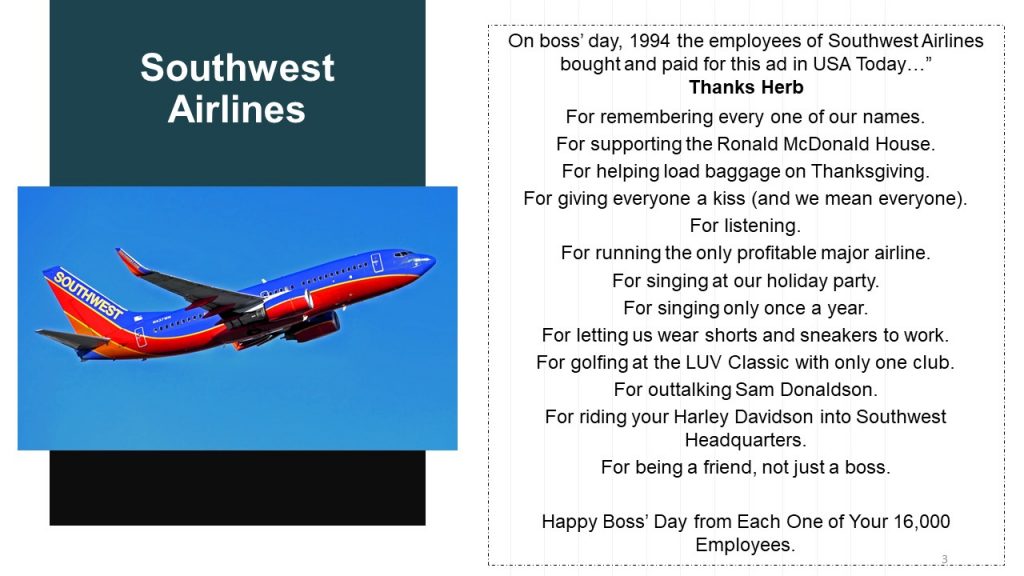
And that legacy did live on in Southwest. Collen Barret , another rags to riches story, and the first woman to have headed a major airline company, took over the President role from Herb. Colleen says
“85% of my time is spent on employees and delivering pro-active customer services to employees.”
Closer home, Girish Kuber, who wrote the book “The Tatas – How a Family built a Business and a Nation” narrates the story of Jehangir Ratanji Dadabhoy Tata , more popularly known as JRD. One of the first actions that JRD did was to take away the special privileges of officers in Tata Steel Plant at Jamshedpur. This included the special reserved lift for the Managing Director, Special dining areas for officers, and special toilets for officers. If you think this was no big deal, think again. This action was taken in the early 1940’s, when such privileges’ were considered absolutely normal. It was the time of British Raj and sahibs in India. JRD used his powers to make everyone equal, instead of seeking importance for himself or the others in office.
It is not the absence of power that differentiates Servant Leaders from Traditional Leaders. It is the conscious choice that they make to use the power that they have for the benefit of the employees. Shakespeare knew it well. He said in his Sonnet No 94
They that have power to hurt and will do none,
That do not do the thing they most do show,
Who, moving others, are themselves as stone,
Unmoved, cold, and to temptation slow,
They rightly do inherit heaven’s graces
__________________________________________________________

This Article is written by Dr. Madana Kumar, UST’s Servant Leadership Evangelist. You can contact him here or connect with him here
Victim, Villain or Hero
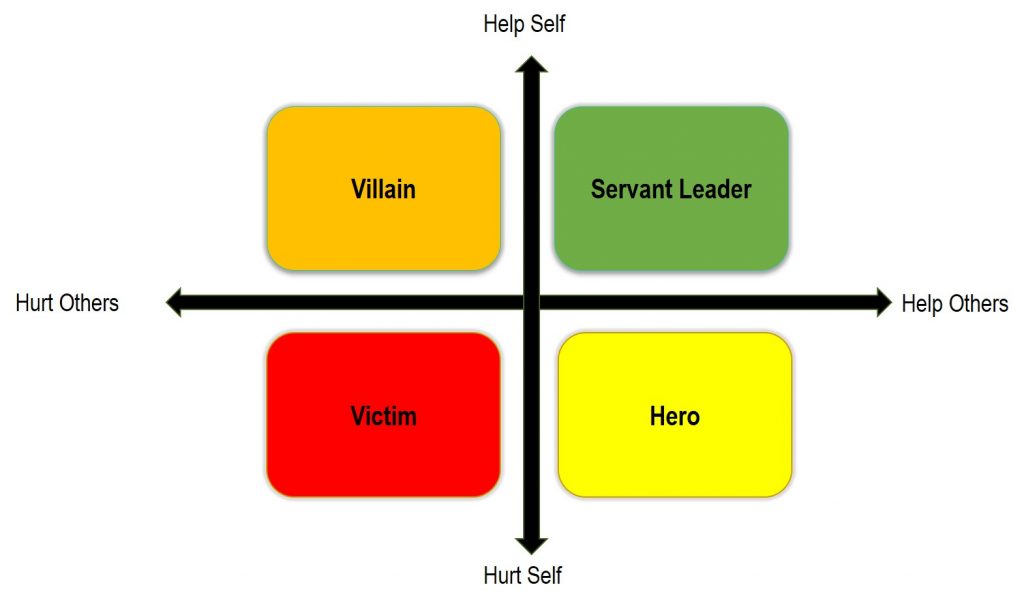
By now, you must have heard it a thousand times. We are living in unprecedented times. We are going through trials. We are preparing for the Future Shock or a new normal. The world is not going to be the same again etc etc. We cannot escape the reality of the pandemic that is still raging out there. But we are also encouraged by the fact that life is slowly limping back to normal. Most of us are learning to “live with” the pandemic.
In this blog, I will ask us to turn the attention on us, on our responses, on how we respond to such trying times. And what can we do as leaders, to be a lot more effective in such situations.
Recently I had the privilege of listening to the author Don Phin, and then read his book, the 40-40 Solution. Don Phin talks about three roles generally all of us audition for viz;, Victim, Villain or Hero. The book inspired me to think about these three categories in a different context. My studies show that these three are the standard responses of people to troubles. Come to think of it, you will see these three roles in any Hollywood or Bollywood movie that you catch on Netflix or Amazon prime or Hot-star or wherever you see movies during the pandemic. Let us look at each one of these three and see which one fits us more.
The Victim response is probably the most familiar one to all of us. When faced with troubles the Victim will feel that it is unfair. The victim will feel singled out. The victim will think the entire world is conspiring against him/her. Their conversation with friends will be about how hard life is. They will strongly feel that others are more blessed than themselves. They truly believe that others do not know how difficult his/her situation really is. They will blame others and/or situations for their suffering and troubles. They think no matter how hard they try, their situation will not change. They find it difficult to get over the past mistakes and failures, and they perpetually live in guilt. You can add on to this list, but I am sure all of us have felt some of the above sometime or the other. Victims are people who feel some of these often.
Phycologists opine that Victims, as and when they can get out of the victim state, end up becoming either a Villain or a Hero. The Victim to Villain transition is very natural.. When one gets fed up with staying in the victim stage, a victim will start planning actions that can hurt others. That is when the Villain is born. A Villain will take revenge. A villain will become aggressive, violent, and will hit back at others with whatever he/she can. A villain will not worry about public opinion. A villain will soon start enjoying the role so much that he/she will fall in love with themselves in that role to the detriment of others. Many of us might not be explicitly getting into a villain role, but think again. We are taking the villain role, when we scream at someone, we are taking the villain role when anger gets the better of us, whether it is at home or outside. Sometimes we get into a villain role without even realizing it.
A more positive transition is the one from Victim to Hero. A Hero does not have to come out of a victim. Heroes emerge otherwise, too. A Hero wants to save. This is what psychologists call the Savior’s Complex. Someone with a Hero Mentality will swoop down on a suffering victim and do all that is necessary to save him/her. At the outset, you may think there is nothing wrong with being a Hero. But think again. All that the Hero might care about is saving the Victim. A Hero might not seek the Victim’s permission or acceptance before getting into the saving act. He/ she might not enable the victim to get over the situation. The Hero might not bother about making the victim self-sufficient. The Hero might not bother about their own safety and/or well-being while doing the saviors act. The Hero will sometimes even endanger himself or herself and many around them, including their own families to perform the rescue act.
Let us pause for a moment and ask ourselves this question in the middle of the pandemic we are in. What role are we auditioning for? Do we feel like a victim of the situation around us? Are we tempted to take on the Villain role, so we can take revenge or we can “pay back” for the sufferings we have gone through? Or are we donning the cape and taking the role of a superhero, trying to save everyone who is suffering, not bothered about our own safety and the wellbeing of the ones who love us?
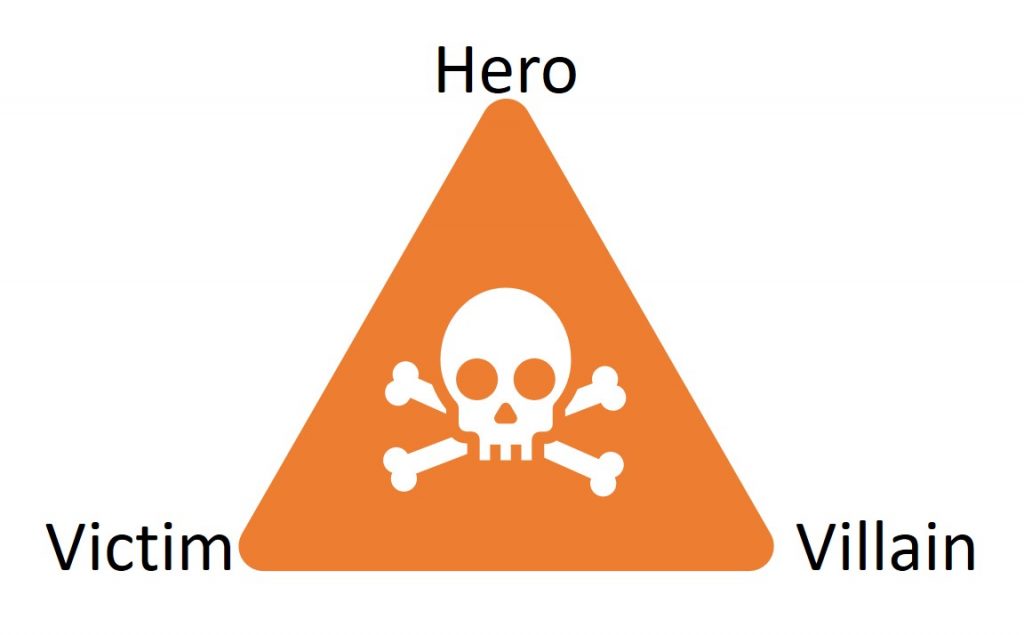
There is a fourth option, an option of being a Leader. We don’t have to be stuck inside the Victim-Villain-Hero Triangle.

So what does the fourth option entail? What does “Being a Leader” mean in this context?
Being a leader as the fourth option here means we demonstrate the behaviour of Emotional Healing that I wrote about in a previous blog. It means Leaders who practice the four habits that I wrote about in another blog. It means we seek to add value to ourselves with the explicit purpose of adding value to others, as described in yet another blog on significance. It means being a Servant Leader.
__________________________________________________

This Article is written by Dr. Madana Kumar, PhD, UST’s own Servant Leadership Evangelist. You can contact him here, or connect with him here.
Servant Leadership and Individual Contributors

It is quite some time since the term “Individual Contributors” made an entry into the Corporate HR jargon. We assumed that almost everyone starts off as an individual contributor and then grows in the organisation to take up leadership roles and responsibilities. Thus, the term Individual Contributor came mostly to be associated with the bottom of the pyramid in the corporate hierarchy. Then companies started realizing that there might be value in encouraging Individual contributors to stay in that role, especially if they are experts in some field or technology. Companies like IBM even created curated career paths for them, so they don’t have to ever take up managerial positions to grow up the corporate ladder, but can reach senior positions without taking up management positions at all.
Studies reveal that developmental efforts for Individual Contributors is focused more on their technical or task-oriented skills and might be for specific roles. Focused investment in “Leadership Development” of Individual contributors was not a focus. Jack Zenger in his article in the Forbes Magazine (way back in Feb 2014) claimed that Individual contributors are “Forgotten Leaders” in investment from organisations on Leadership development activities. Several Organisations ask, “What has leadership development got to do with Individual contributors?”
That led me to the question. How about Servant Leadership? Can an organisation really develop a Servant Leadership Culture by focusing only on who we traditionally call leaders? And the answer is “no”. A Servant Leadership culture requires that we focus on this group of “forgotten leaders” as much as we focus on traditional leaders. All individual contributors are “leaders” if we go by the definition “Leadership is Influence”. That is why I refer to Individual Contributors as Self-Leaders.
What do these Self-Leaders need to do so they can take the best advantage of a Servant Leadership culture in the organisation? What attributes or mindset changes or behavioural changes do they need to embrace so they thrive in a Servant Leadership Culture and make the organisation successful? My studies show that there are three areas where they need to develop. (Ken Blanchard and Susan Fowler articulate this better in their book “Self-Leadership and the One Minute Manager”)
These are the building blocks for Self-Leadership. So let us not forget the “Individual Contributors”. Let us invest in them and make them significant Self-leaders. This will speed up the spread of Servant Leadership culture within the organisation.
____________________________________________________

This Article is written by Dr. Madana Kumar, PhD, UST’s own Servant Leadership Evangelist. You can contact him here, or connect with him here.
Empowerment
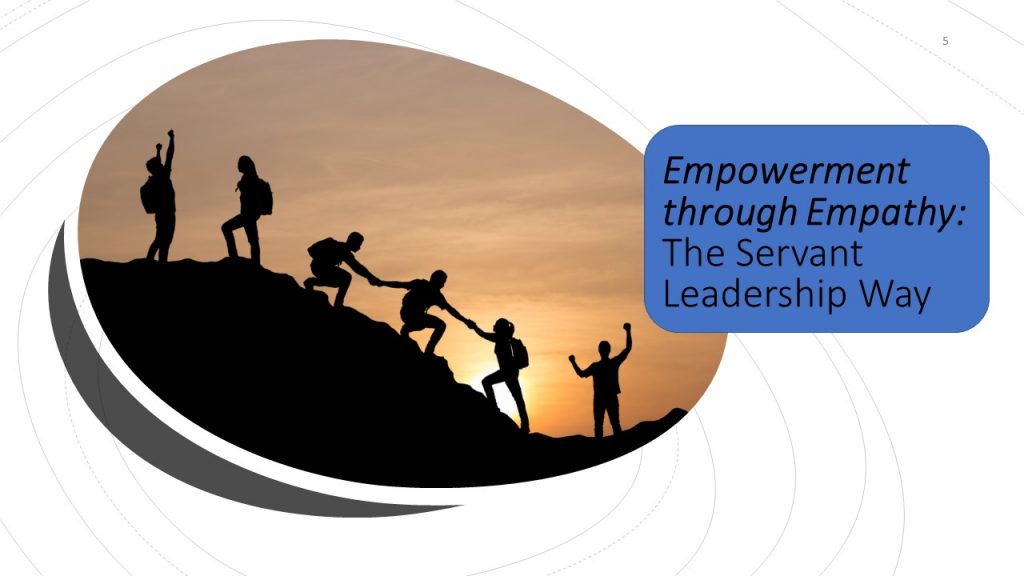
In my previous blog I discussed the need for Servant Leaders to be able to dream big and keep boundaries while chasing such dreams. At Leadyne, we call it the behaviour of Demonstrating Conceptual Skills. This is the beginning of great organisations.
So, what is next? Is setting a higher purpose vision and goals enough by itself? The obvious answer is “No”. Visioning is one of the two key leadership roles. The second one is Implementation. During Implementation of the vision, mission, goals and values, Servant Leaders step aside and invert the pyramid. They create a culture where the employees feel they are fully responsible for the implementation of the vision, mission , values and goals. However the employees also know that the leaders have not gone anywhere. They know they can call upon the leaders as a resource when they need. The employees become responsible and the leaders become responsive to the employees’ needs. They serve the employees in fulfilling the organisation’s vision, mission, values and Goals. This concept is called the “Inverted Pyramid” and is an integral part of Servant Leadership Culture.

To make the Inverted Pyramid work, Servant Leaders rely on another of the DEEP BHC behaviours viz; Empowerment. It is a very commonly used word. But let us dig a little deep into it.
Is Empowerment something that you “give” to your followers? Have you heard some leaders claim “I have empowered my team fully.” When Empowerment is something that the leader “gives” to their followers, the leader is implying that the power remains with me and I give you the part of that power. This is like claiming that you are most humble person in the whole wide world. Empowerment is not something given, but Empowerment is a climate that is felt by the followers. When they feel that they are Empowered to make decisions, even make mistakes, that is true empowerment.
Chris Croft talks about the Freedom Ladder. Servant Leaders need to make conscious efforts to bring their people up the ladder, not by mere words but by appropriate behaviour. Let us take this conversation for example.
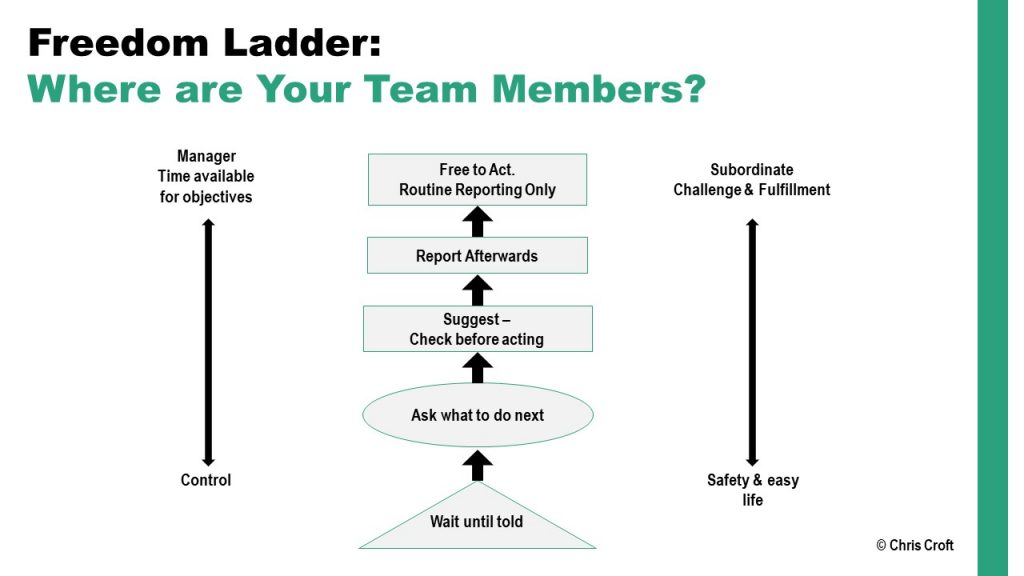
Quote
John: Hi Vinod. I found a problem with the code that we were supposed to release for the client yesterday and I have solved it by making some adjustments. I have released it to the clients and met the timelines committed. Just wanted to let you know and see what you think
Vinod: Thanks John. You did well. May I suggest that in future, you pass such things through me before you release it to the clients?
Unquote
What do you think just happened here? John was at level 4 of the Freedom ladder and wanted to operate from there. Vinod’s reaction was a very clear message that Vinod wants John to be at level 3 of the Freedom ladder. What do you think John will do next time when faced with a situation like this? John is going to suggest and wait for Vinod’s approval before he does anything. In other words, knowingly or unknowingly Vinod has “pushed” John to Level 3 of the Freedom Ladder. This is what happens when the leader is not sensitive to the feelings of the team members while responding, even when the leader considers himself/ herself as am “empowering” leader.
Therefore, at Leadyne, we map the behaviour of Empowerment to the attribute of Empathy. Unless as a leader is able to put himself/herself in the shoes of the employee and understand how they feel, empowerment cannot happen. It is important for leaders to understand what the team members think and feel. That is why I said at the beginning that Empowerment is a climate that the team member feels.
True empowerment needs that you demonstrate behaviours that will help and encourage your team members to operate from Level 4 or level 5 of the Freedom ladder. Sure, there are risks in doing this. But in the long run, it will become a much stronger team and you as a leader will have a lot of time in your hands for doing higher purpose activities.
Come join the Servant Leadership Movement and learn how to make your teams feel empowered.
_____________________________________________________

This Article is written by Dr. Madana Kumar, PhD, UST’s own Servant Leadership Evangelist. You can contact him here, or connect with him here.